Ep.45: Devilman The Classic Collection Vol. 1, by Go Nagai
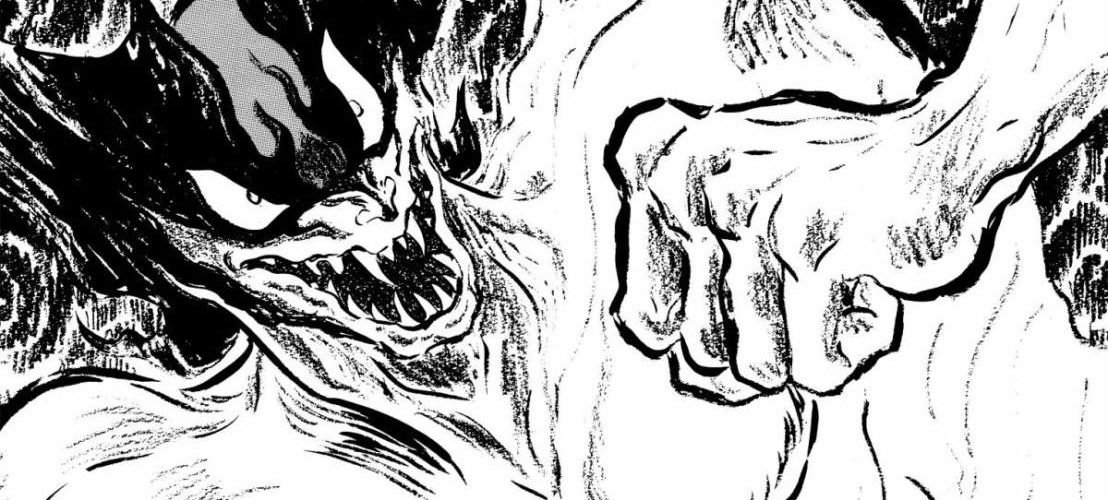
Keeping up with your new year’s resolutions? Akira resolved to save all of humanity by combining with the power of the Devil to become DEVILMAN, in one of the wildest manga the Mangasplainers have ever read. Something to shoot for, for next year’s resolution, eh? Plus a reader Q&A about ‘indie’ manga. Check it out!
Powered by RedCircle
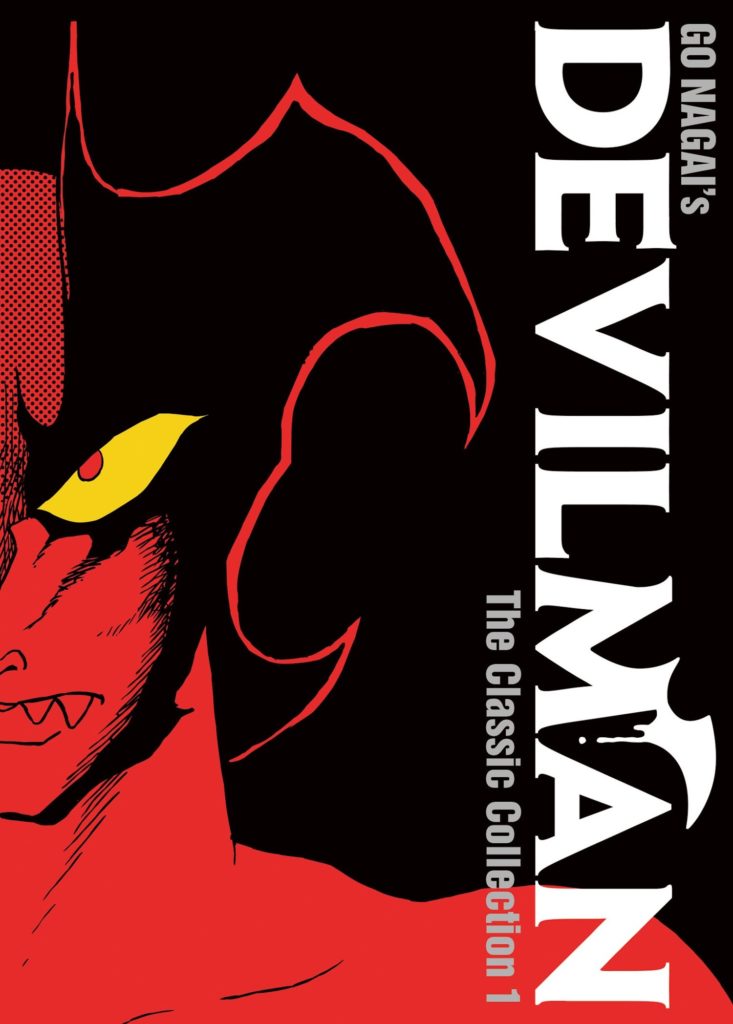
Go Nagai’s Devilman: The Classic Collection Volume 1
By Go Nagai
Translated by Zack Davisson and Adrienne Beck
Lettering and Retouch by Bambi Eloriaga-Amago and Roland Amago
Cover Design by Nicky Lim
Published by Seven Seas Publishing (Print Only Edition)
Show notes by Christopher Butcher and Deb Aoki. Audio Editing by David Brothers.
Before We Get Started:
Spoilers, first and foremost. For the whole series, and some of the anime too.
Content note: There’s a lot of nudity and body horror, albeit cartoony, in this manga and therefore, stuff we describe in this episode, so it might be a lot for some listeners and viewers. If you don’t want to see boobs, butts, and some gross stuff happening to them, this might not be the show notes for you.
Thirdly, all images used in this article are for the purposes of review and commentary. They are photographed from the printed book, and as such, they may be distorted slightly and do not reflect the quality of the printed book (which is lovely).
Fourthly, Let’s talk about Go Nagai!

Go Nagai (real name: Kiyoshi Nagai) was born September 6th, 1945, in Wajima, Ishikawa, Japan. He is a prolific manga author credited with inventing many genres and styles of manga over his long career, which continues to this day.
Among his many accomplishments is the creation of the Super Robot genre in his manga Mazinger Z, which refers to robots piloted by humans in their cockpits, rather than controlled from outside, typified by another of his earlier series’, Getter Robo.
He is also credited with the creation of magical girl manga with his manga Cutie Honey, though the genre did go in a somewhat different direction after this work, which is epic-ly violent and sexy.
[Deb:] In addition to publishing Devilman, Seven Seas also published Go Nagai’s Cutie Honey manga and the rebooted/updated version of the story, Cutie Honey A Go Go. Cutie Honey is maybe best known for its busty heroine, and how Honey’s clothes tend to get shredded while she’s in action. It’s probably one of the stranger magical girls manga around… and that’s saying a lot. Go read it and see why David says it’s popular with “some 45-year old men.”
[Christopher:] Perhaps his most infamous and influential(!) manga at the time it was created is Harenchi Gakuen (Shameless School), which added erotic and sexual content to a high school gag manga, creating the ‘ecchi’ genre of manga that is still very popular to this day. Harenchi Gakuen was one of the first series featured in Weekly Shonen Jump. It was so popular that it spawned live action films and a TV series, but was also widely protested by PTA groups, women’s associations, and other corners of conservative society. These groups eventually ‘won’ the battle, getting Nagai’s manga temporarily suspended from publication, but not before Nagai offered a final, parting middle finger to the PTA groups by turning them into bloodthirsty murderers, who viscerally kill all of the characters of Harenchi Gakuen in its ‘final’ chapter. Pretty wild.
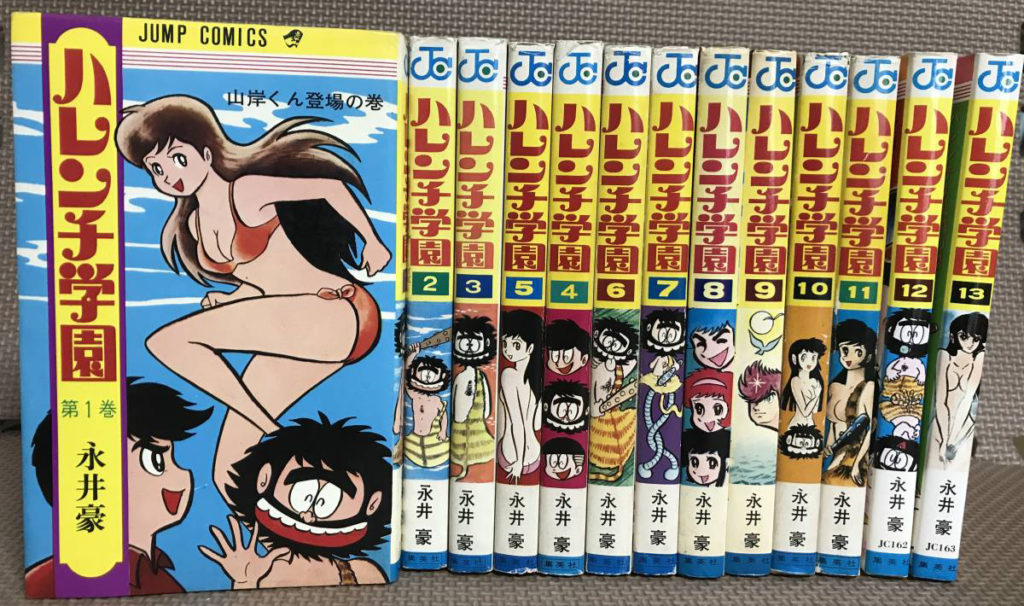
[Deb:] In recent years, Nagai has defended Harenchi Gakuen, describing it as being a critique of Japan’s “culture of shame.” In this overview of the controversy published in Otaquest, he says:
I did have proper morals and, in fact, I fought hard against myself not to go too far because I knew that I was being published in a kids’ magazine. There are lots of different kinds of “erotic,” and what’s erotic to one person is different from another. Humans are living creatures, and like any other living creature we’re obviously drawn to the opposite sex. I thought that if I didn’t draw that, then I wouldn’t be representing humanity, I wouldn’t be representing society.
– Go Nagai, from a 2007 interview
[Christopher:] Showing that creators can get absolutely screwed over by their publishers on both sides of the Pacific, it turns out that Go Nagai didn’t make any money from any of the Harenchi Gakuen licensing. After this experience, he formed his production company, Dynamic Productions, as a studio and rights management company for him and his work (manga and anime) in 1969. Tezuka and maybe a few other manga-ka had created production companies as well by this time too, which is interesting, and many established creators do just that these days, on both sides of the Pacific.
One of the things you won’t quite get from the Wikipedia articles is just how prevalent Go Nagai’s creations were at the dawn of commercial anime and manga fandom in the early 1980s. Anime based on his series’ listed above, as well as his creations Violence Jack, Grendizer (known as Goldorak in France), Shin Getter Robo, Amon, and of course Devilman and its sequel Devilman Lady (aka DevilLady), were a big part of the early direct-to-home-video, legitimate anime releases in the 80s and early 90s.
His work really helped anime deserve it’s reputation for extreme violence and sex, you know? His work is also very popular outside of both Japan and the English speaking world, with his manga pretty widely translated into French, Spanish, and Italian, among other languages. Moreover, all of these series (and many more) will constantly get sequels, remakes, crossovers with each other and outside properties, and all of the kind of ‘iterative’ publishing that you see in North American Superhero publishing, which is pretty different than most manga, even ‘classic’ manga series’.
So I do wanna say we’re pretty glib this episode, but Nagai is a legit GOAT creator, despite the problems with his work, and he’s hugely influential in ways you can’t always see. This is absolutely a book worth checking out.
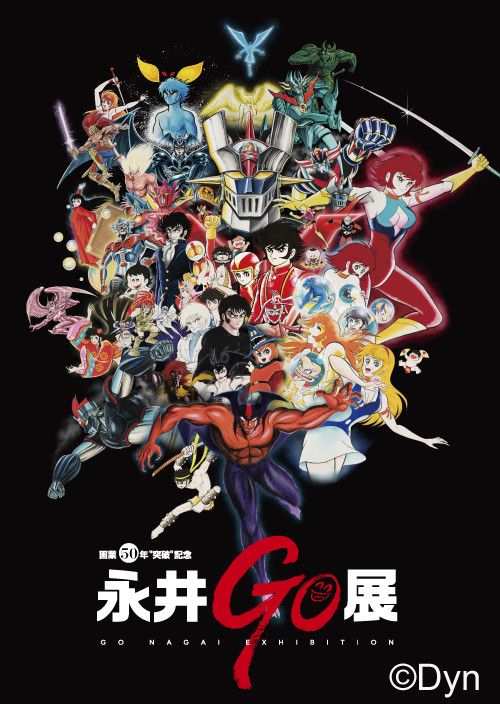
00:00 I don’t know that we actually explained what this book is about, at the beginning. So here’s the book description from the website.
Go Nagai’s groundbreaking horror classic that inspired the genre for decades.
Hordes of demons, once thought entombed forever in the underworld, have now returned to Earth. Evil and corruption begin to seep into our world, as demons seize human hosts. Mankind’s only hope for salvation is to use the demons’ power against them–and only a pure-hearted man like Fudo Akira can do so without losing his humanity. Once little more than a crybaby, Akira now wields the terrible power of a devil, yet holds the innocent soul of a man–Devilman!
Seven Seas Website
01:20 So the ‘BEST FRIEND’ is… a hint about this series. These fellas, Akira and Ryo, sure do a whole heck of a lot of embracing for just being bros. More to come.
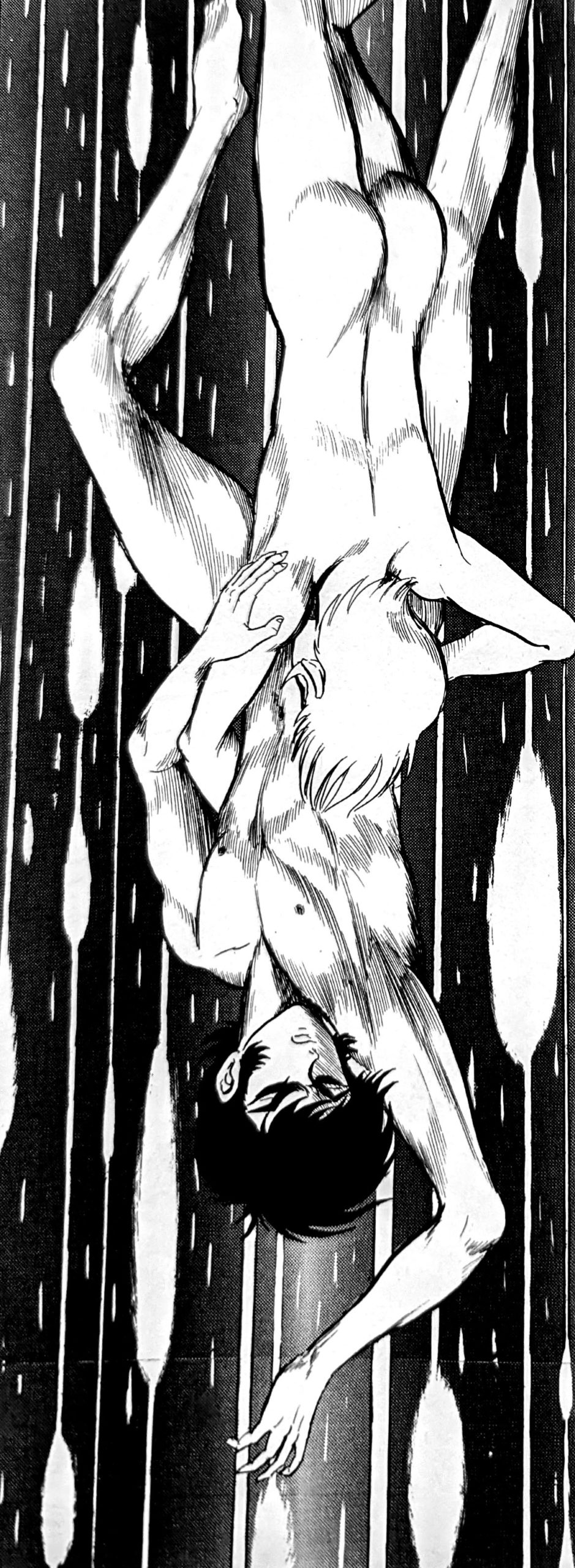
02:05 As David mentions, there was a live action Devilman movie made back in the 1990s that was released at the time in North America by Media Blasters. It’s now free to watch over on TUBI. Enjoy!
02:30 The Guyver is another live-action, medium-budget horror/sci-fi movie based on a manga series that features extensive prosthetics, make-up, monster suits (Japanese tokusatsu-style shows, we’ll get into that with Kamen Rider in a few weeks), that was released in the early 1990s, and did really well in your local Blockbuster Video (Jumbo Video, in Canada). It co-stars Mark Hamill when his career was on something of a downswing, but it’s a VERY watchable piece of trash cinema. It’s not free to watch anywhere, maybe Hamill’s people are keeping that shit off streaming, but you can see the trailer on the IMDB page: https://www.imdb.com/title/tt0101988/
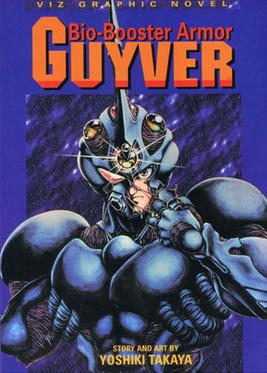
03:50 David mentions the animated series Devilman Crybaby, a Netflix Original anime directed by Masaaki Yuasa. It’s probably how most of you reading these words know what Devilman might be. As David and Deb mention, it’s a good, but very dark and heavy anime series that adapts the main story of Devilman. No time-travel or side-stories, but a very interesting update / reinterpretation of the story.
[Deb:] For other takes / remixes of the Devilman story, check out these other Devllman manga spin-offs, also published by Seven Seas Entertainment: Devilman vs. Hades by Go Nagai and Team Moon — a 3-volume story about how Devilman goes to Hell to wage war against the gods of the underworld. Devilman Grimoire is a complete retelling of the story in 5 volumes.
04:50 So, funny story, the first mention of Devilman on the podcast was in the context of the color Devilman 3-issue series that Verotik published in 1995. The colour page on the left is from the Verotik edition, the black and white page on the right from the original/Seven Seas edition.
Also the Verotik edition had this sweet Bisley cover on issue 3, which is metal as all heck.
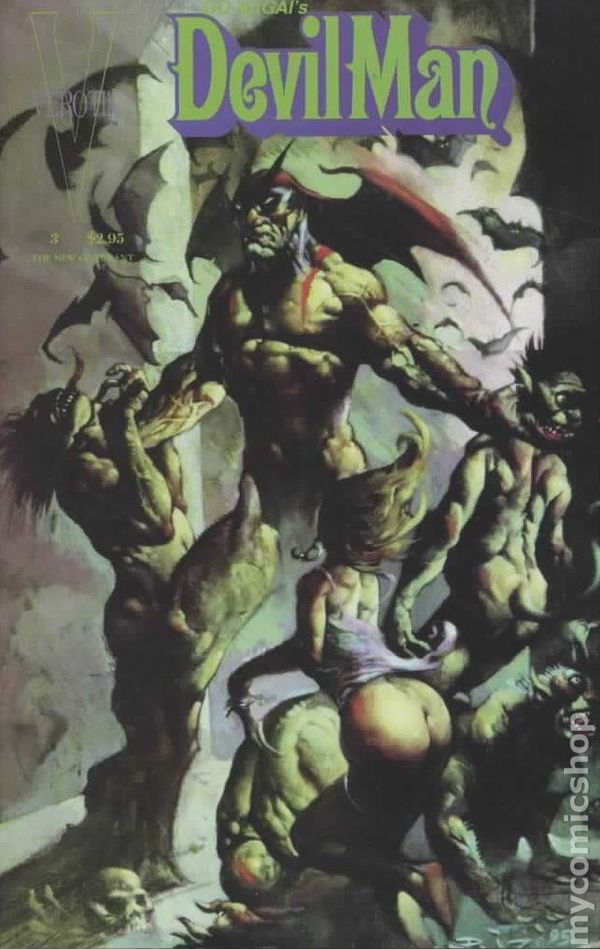
If you check out this short tweet thread by comics commentator Jog on twitter here, he mentions that this Verotik series is, essentially, three of the time-travel stories that appear at the end of this volume as a three-issue mini series. The Hitler, Joan of Arc, and Roman times stories, specifically. Also, as I suspected (and we dig deeper into later in the episode), these stories are actually from the sequel series Shin Devilman (New Devilman), which retroactively inserts time travel stories with Akira and Ryo made years later into the main Devilman chronology. He mentions that no one is talking about Seven Seas doing this, and that’s kind of my whole complaint a little later. Anyway check out that link, there’s some interesting art comparisons there.
06:45 “But those boobs!” Chip’s not just a pervert, the Akira comments on Maki’s boobs in more-or-less that way in the book itself.
07:00 So yeah, David mentions mentions Parasyte, the manga by Hitoshi Iwaaki, and he is not, in fact, talking about Parasite, the Academy Award-winning film directed by Bong Joon-ho. Common confusion.
“This is like if unrestrained id wrote a comic.”
Christopher Butcher, on Devilman
09:35 This dead-end panel just killed me. I feel like it was maybe a serialization-break in the original Japanese, and then this page was edited for the collection later. I could be wrong of course, but it just seems so…? “Make it work, and keep going.”
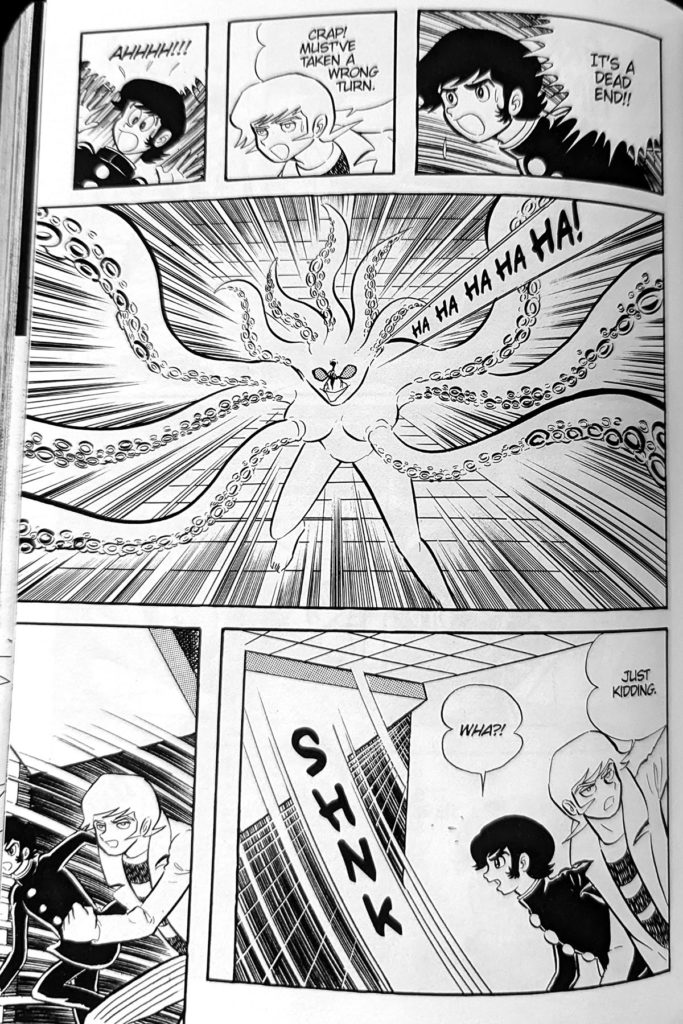
12:00 The Turtle sequence. So yeah, both this short story, about the turtle demon and the little girl, and the later one with a the little boy’s parents secretly being monsters, are probably the strongest horror stories in the book, IMO. I’ll talk about that again in a few minutes, but for now, please enjoy what passes for the softer side of Devilman.
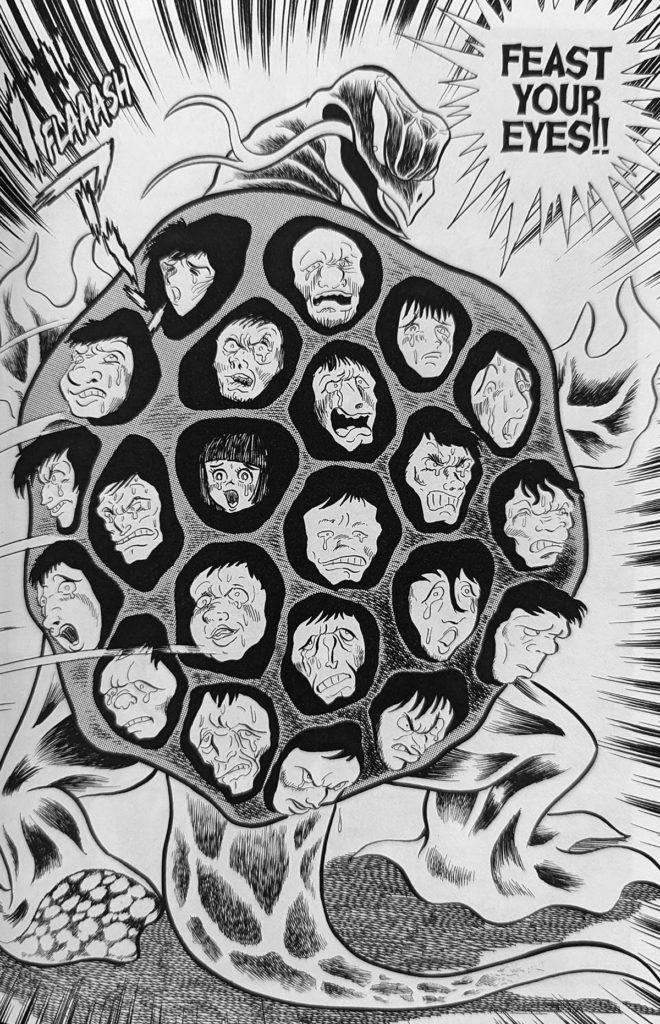
Then, some stuff happens. And…
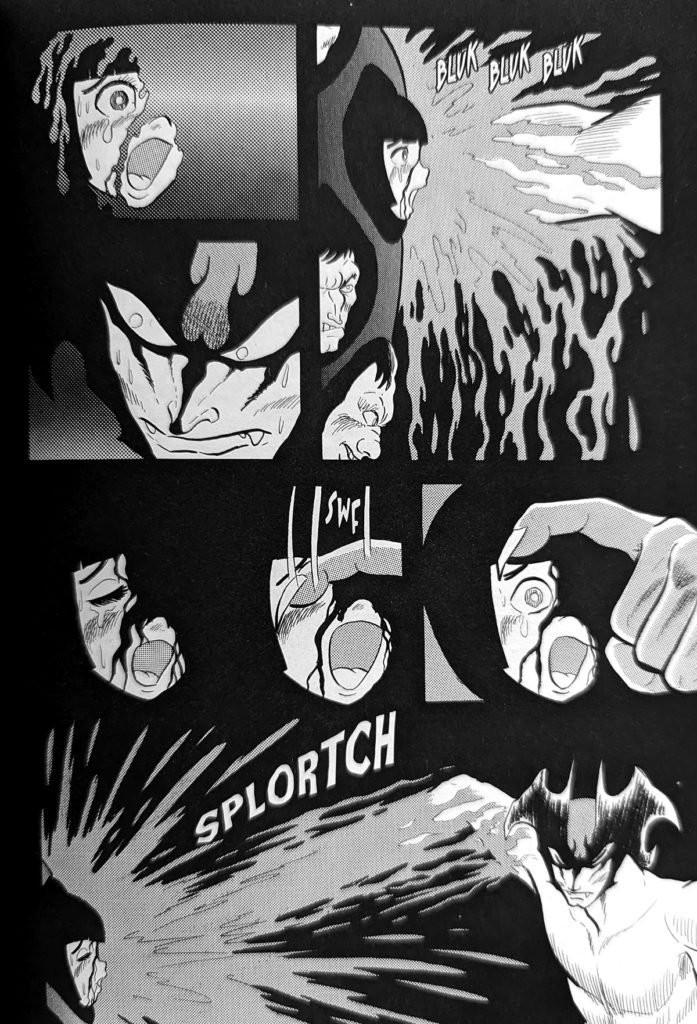
15:30 There’s some REALLY great drawings of Devilman in this manga.
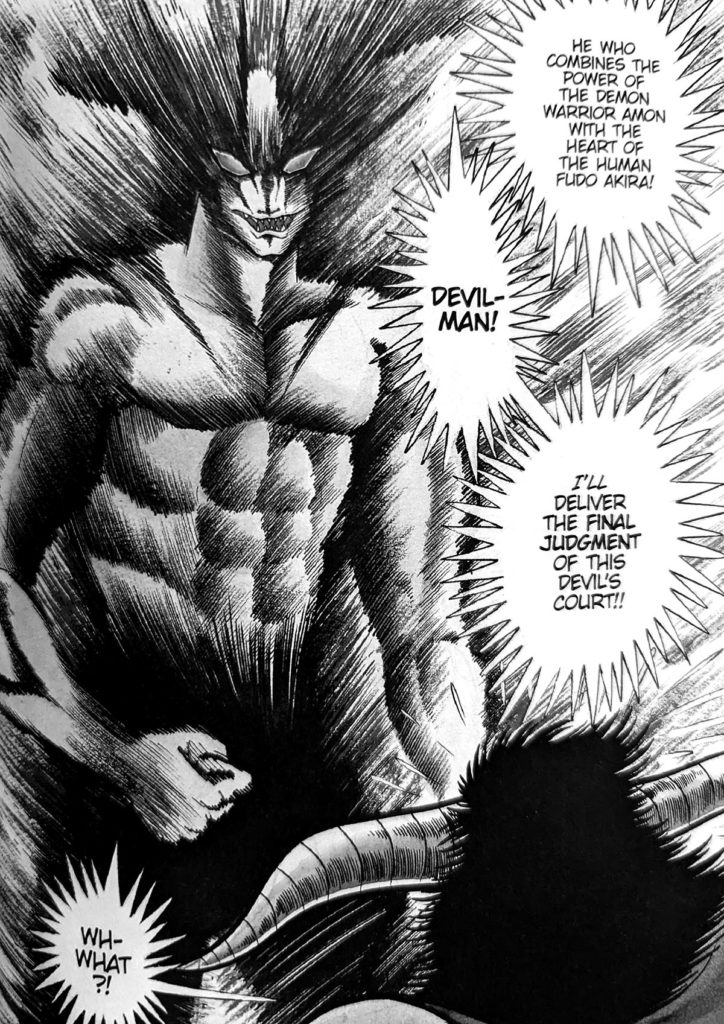
16:37 Yeah, the drawing of Ryo pointing directly at the reader on Page 168 really is something else. Keep in mind that this series was a weekly shonen manga, and Nagai was probably working at 2-3 series at a time, drawing 10 pages a day… sometimes you can really feel it.
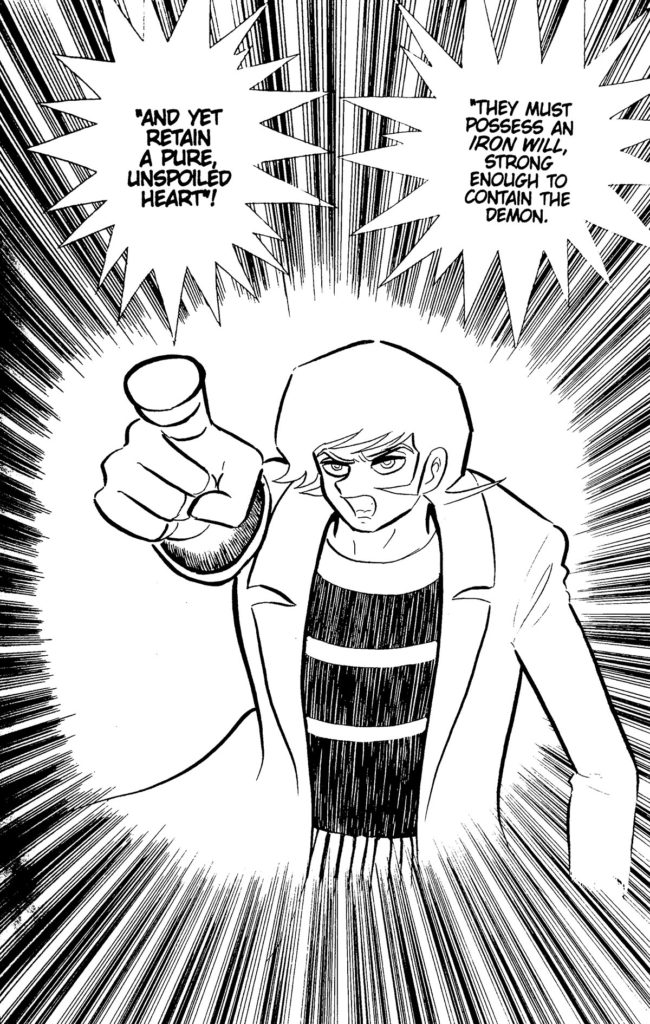
17:30 [Deb:] For you young ‘uns out there, “Charles Atlas” refers to the body building ads that were a familiar sight in 1960s-1970s comics, where a skinny lad gets sand kicked in his face by a bully, takes up body-building and becomes MANLY.
Haha, the before-and-after eyebrow comparison is great. FWIW, this ‘after’ eyebrow comparison is from the first page of what would’ve been volume 2 in the manga collections, and the scene with Akira and Maki is meant to mirror the same scene from the beginning of volume 1, with a very different outcome. It’s just bizarre that these are a volume apart, rather than a chapter or two within the same book…
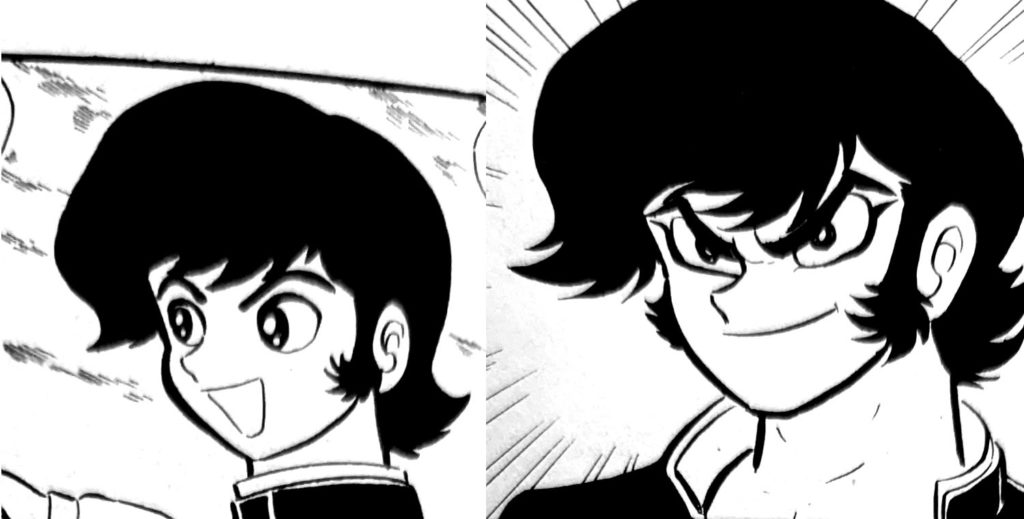
17:50 The idea of Ryo showing up to offer ‘drug-laced’ cigarettes to John Allison‘s Bad Machinery kids is certainly a fun one.
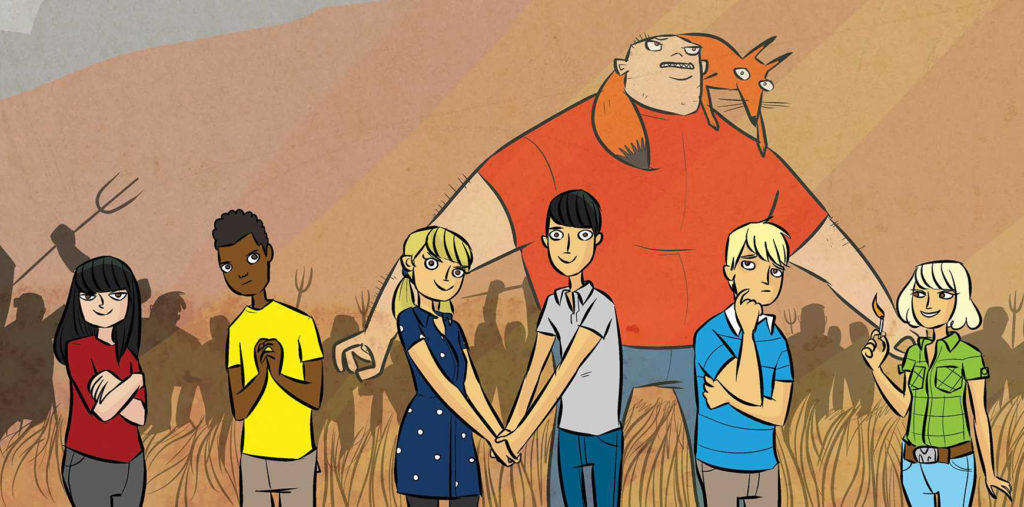
18:20 I was going to insert the double-page reveal spread of ‘The Hippies’ here, but it’s just too darned good, honestly. I don’t wanna spoil the surprise, it’s worth seeing in context.
19:00 However, the Hitler page that Chip cites as his absolute favourite? We’re definitely including that.
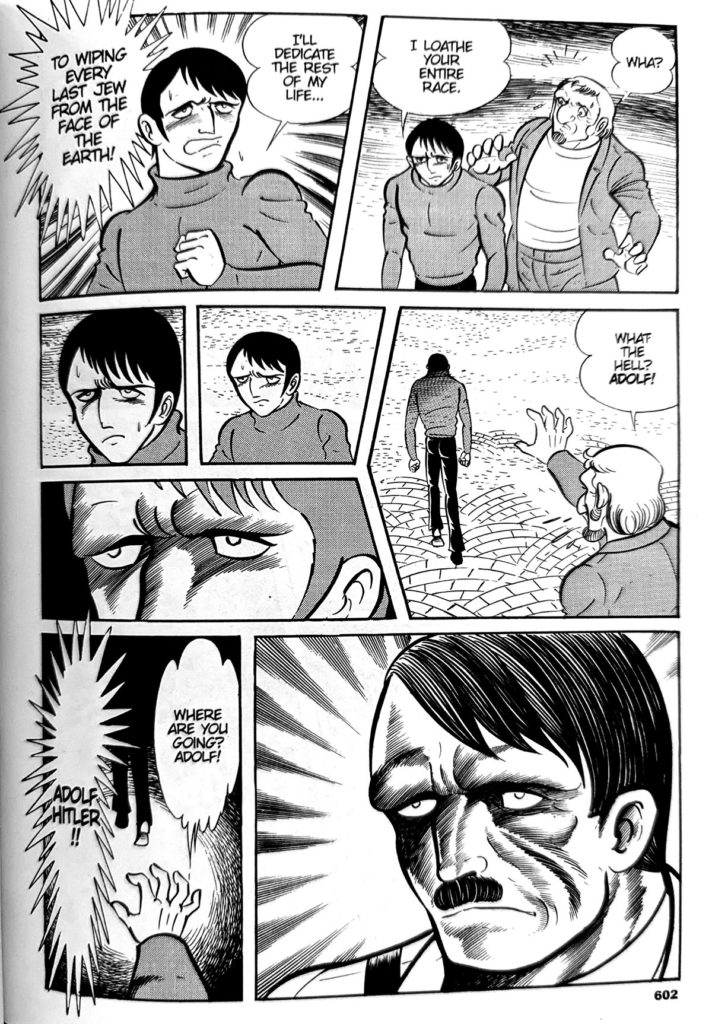
Yikes.
21:00 APPARENTLY, Chip hates heavy metal album art. Look at how beautiful this is.
Angels with massive boobs and little wieners, on the run (fly?) from apocalyptic devils. If that isn’t the left side and right side of the bitchin’est van of all time, I don’t know what is.
23:00 There’s just a lot of nude embraces as characters fall through time. Hell, Ryo is nude for the entire last story of the book. Shin Devilman is on a whole other thing.
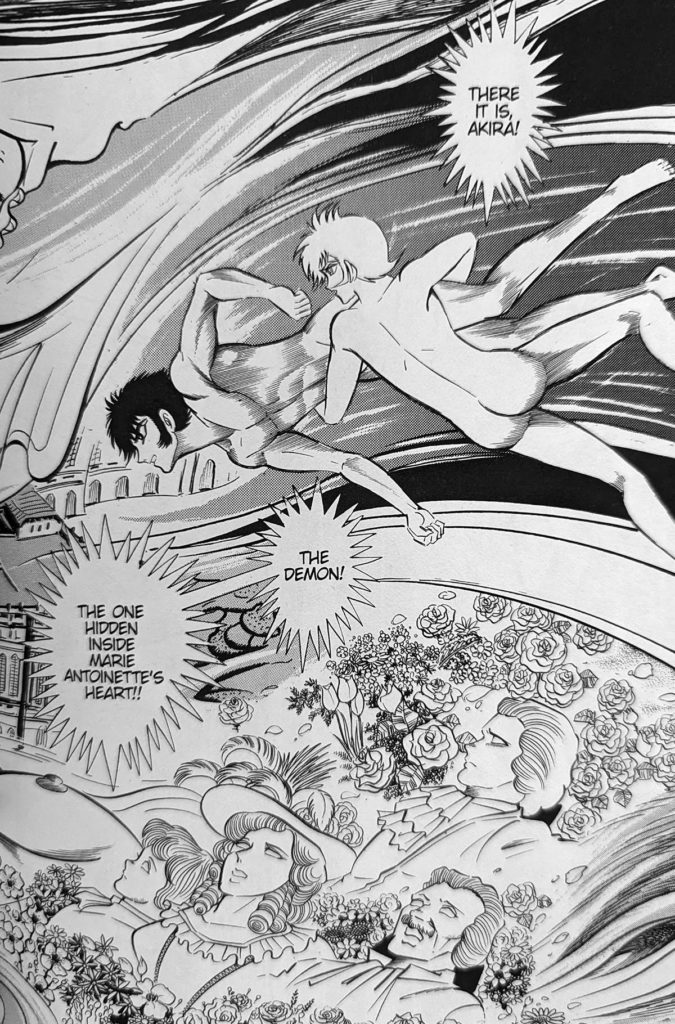
24:00 David mentions a thing here that sounds a little weird out of context, but that’s what these show-notes are for, right? I’ll try to be brief but cover what all, exactly, this means.
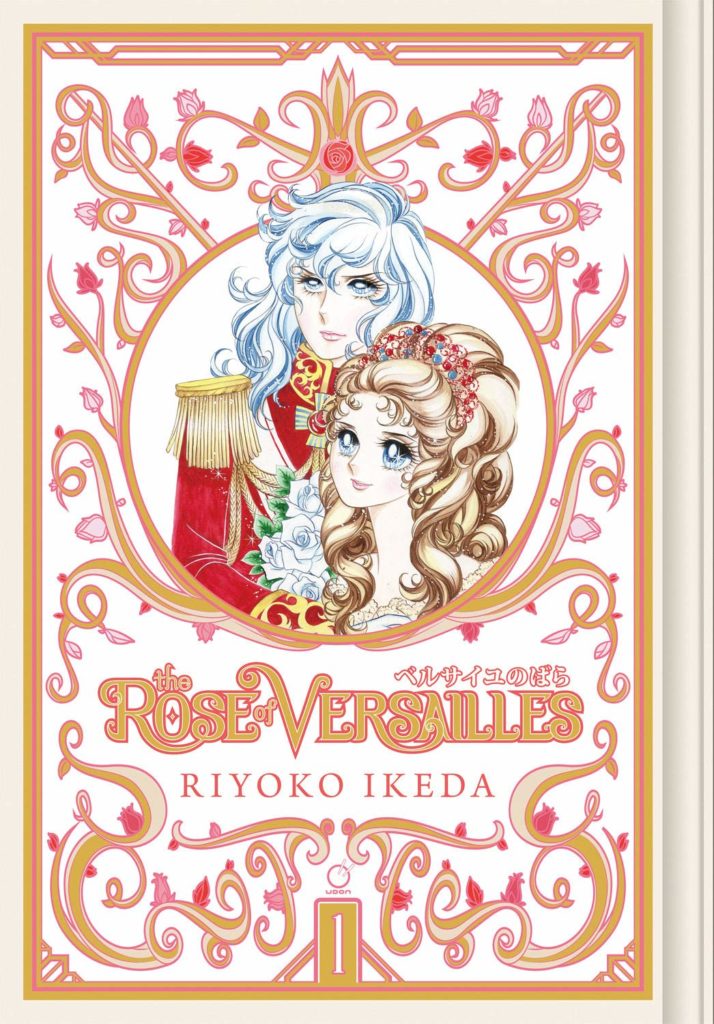
So there’s a manga called The Rose of Versailles by manga-ka Riyoko Ikeda. It ran from 1972-1973 (and has had new short stories pretty consistently since then) and it’s one of the great, classic, foundational shoujo manga works (that I swear we will cover on Season 3 of Mangasplaining). The Rose of Versailles is a historical drama set in years preceding and during the French Revolution, mixing both historical persons (Marie Antoinette, Queen of France), and original characters (a woman named Oscar Francois de Jarjayes, commander of the Royal Guard and raised as a boy from birth).
The manga became a huge critical and commercial success, one of shoujo manga’s earliest, and even aged-up the entire genre from a children’s genre to a teen/YA genre. It incorporates left-wing ideological themes that were gaining strength in Japan-post war by showing the terrible behaviour of the ruling class, and also had a lot to say about gender and gender roles due to Lady Oscar being a military commander. Its popularity made it incredibly influential both inside and outside of shoujo manga. It makes perfect sense that if you’re a manga-ka in 1979 doing time travel stories, you’re going to go to the time period that had been popularized in one of the biggest manga of the decade, at that time.
Which brings us to the Takarazuka Revue, an all-female musical theatre troupe founded in Takarazuka, Japan (just outside of Osaka) in 1913. The Takarazuka Revue is the most famous “western style” theatre troupe in Japan, a response to traditional Kabuki performances which would see all roles performed by male actors. As you might imagine, a hugely popular period-piece manga with a female character taking on a traditionally male role was Very Interesting to the Takarazuka Revue, and the Revue adapted the wildly popular manga to a musical performance in 1974. It has long been one of the most popular and beloved stories performed at the Revue, so much so that that statues of Lady Oscar, and her attendant and lover André, adorn the street between the train station and theatre in Takarazuka.
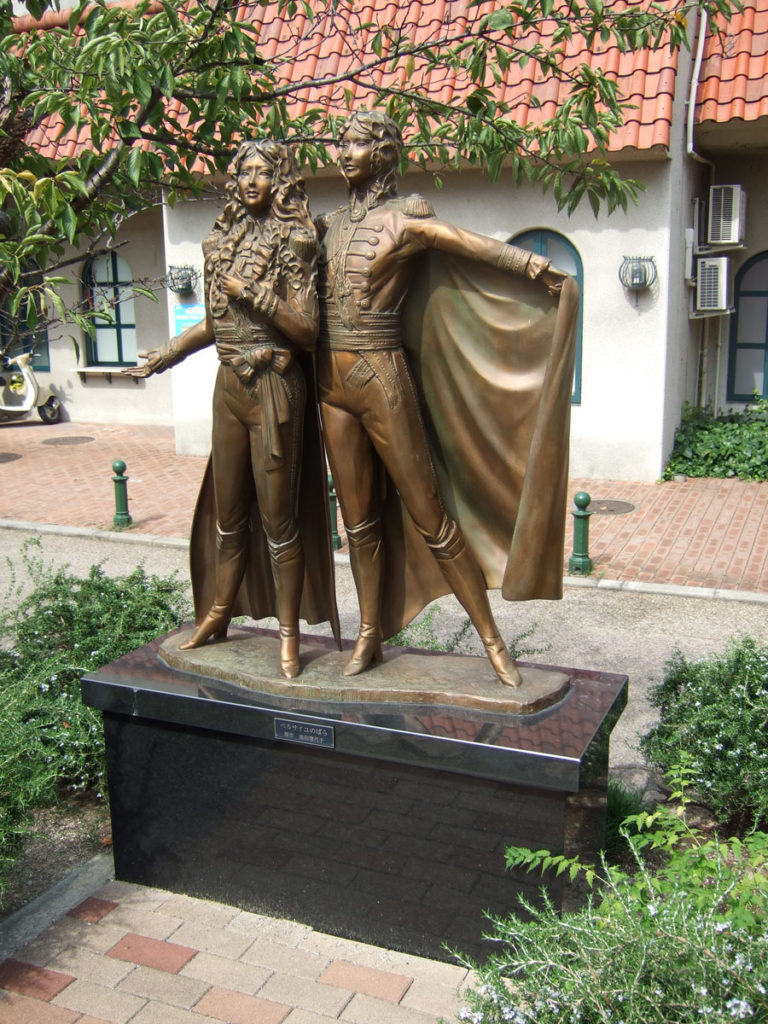
Which brings us to David’s “Video of Lupin III being performed at the Takarazuka Revue and he gets sent back in time to the time of Marie Antoinette.” Lupin III is a famous manga series by the artist Monkey Punch (The “Classic Heists” collection of Lupin III manga was recently published by Seven Seas!), the Takarazuka Revue often creates original stories as the basis for Revue performances from various manga, and there’s just something special about the time just before the French Revolution, the decadence really lets you use some great costuming….!
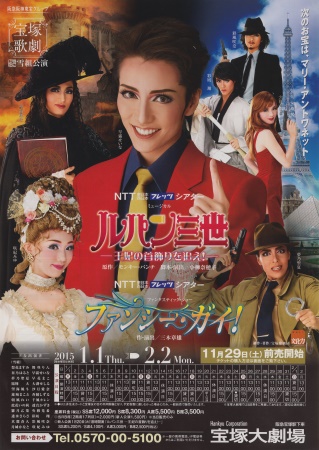
25:20 So first up, let’s talk about these bullies.
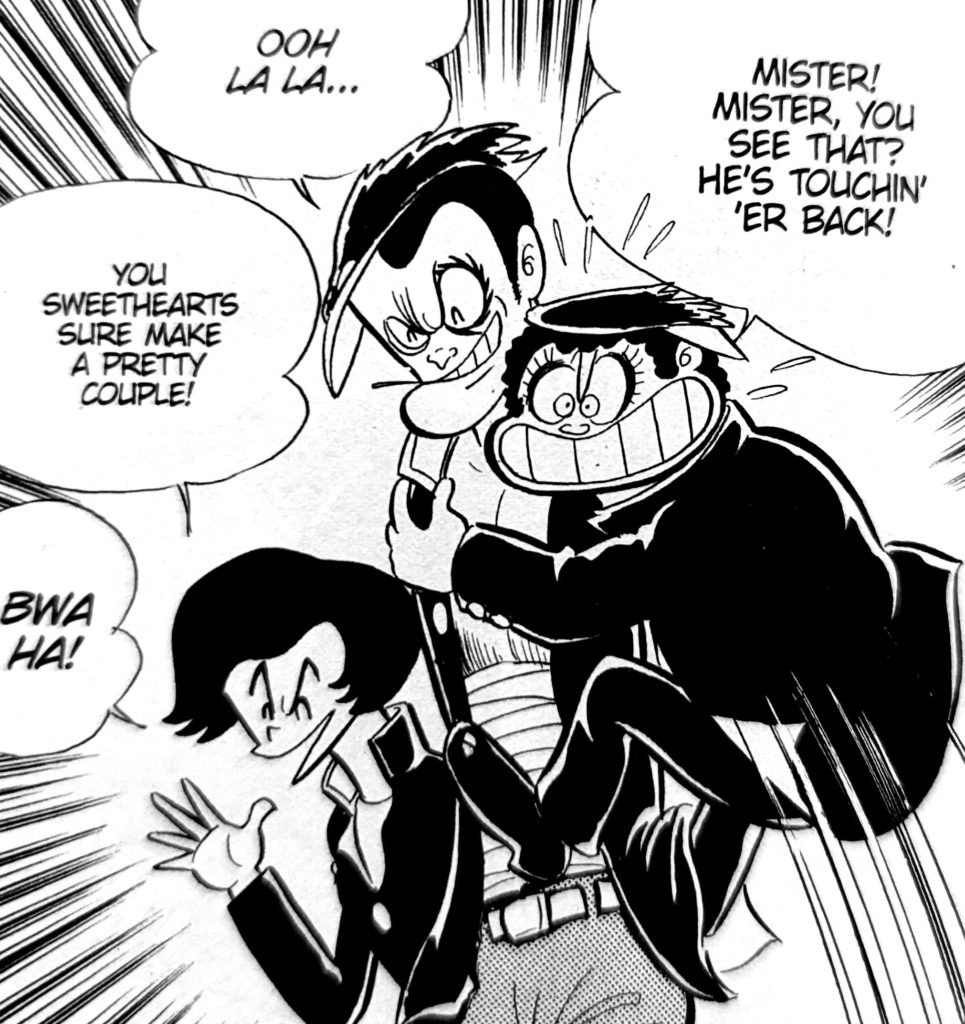
“Right outta Central Casting,” is very accurate. These bullies are like, the perfect manga personification of ‘rough’ bullies. You can tell that Go Nagai spent years and years doing high-school gag manga before Devilman.
Then as Chip says, there’s just no consistency in the face of this smug teacher type on page 450.
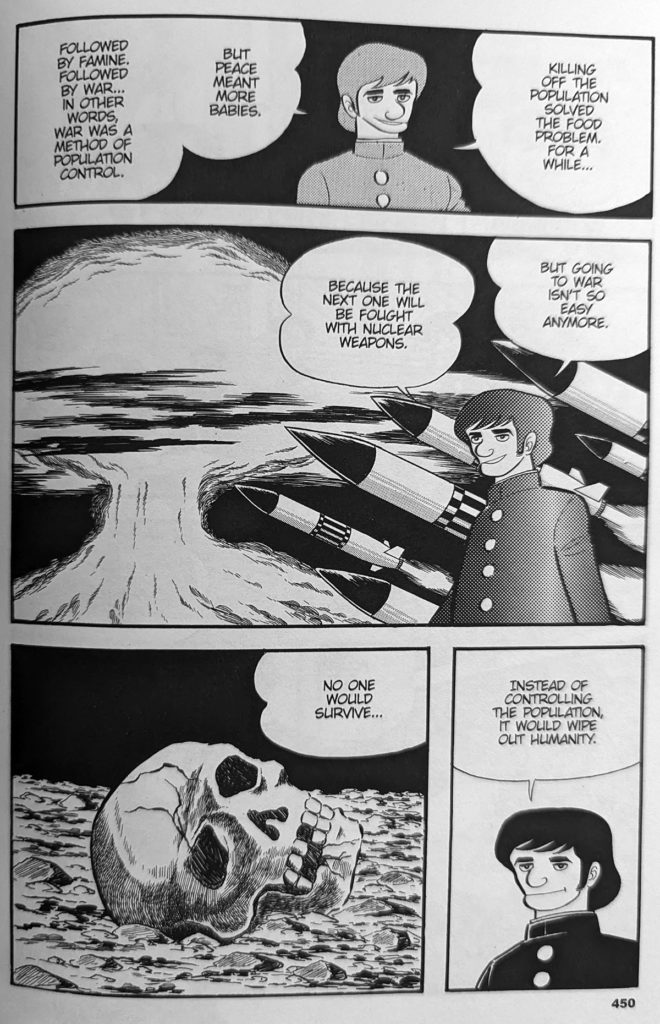
26:30 So that cartoonist for SUCK.com is Terry Colon, and his work is some fun caricature that definitely gets even a little abstract at points.

27:45 Here’s that page I mentioned from Chip’s series Kaptara, with (and by!) artist Kagan McLeod:
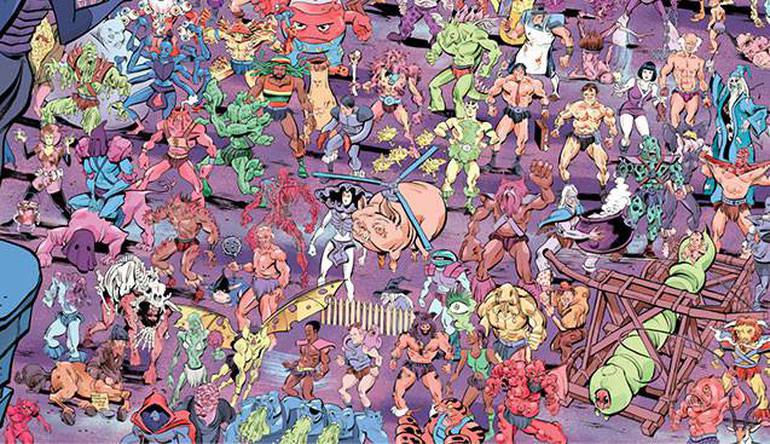
30:15 Deb’s bang-on here, the pacing in this is just… all over the place. Like the entire first 200+ page volume, which doesn’t actually show Devilman until almost the end of the volume, is paced (from a plot perspective) exactly like the first episode of an anime… except its more than 200 pages long! Then volume 2, starts with the new-eyebrow stuff above… which would be the second episode of the ‘anime’ version. Making matters worse, a 20-page nearly-wordless colour sequence is added before volume 1… and honestly from reading reviews online it seems like volume 2 is worse at this, not better. And that brings us to my main problem with this book.
So we gotta talk about what Devilman Classic Collection actually is, it’s the ‘Graphic Novelization’ of the original-timeline Devilman material. Shout out to the Devilman Wiki and a few other online sources for helping me finally put it all together. I was making best-guesses during the episode, but I did some research as we were talking, and now for this, and yeah, Devilman Classic is not an ‘archive’ or ‘reprint’, but a reordering of most of the ‘classic’ Devilman material into roughly chronological order, including the original Devilman 5 volume manga series, the Shin Devilman short-story volume, and a selection of one-shot stories that appeared in various reprints in Japan over the years. It also is an edition that excises a lot of additional material, including a bunch of pages and a few short stories.
And that’s fine.
Except there’s nothing in the book that mentions its publication history. The book swings wildly in tone and quality and style because of the insertion of short stories and pieces completed 10 or 15 years after the fact, and there’s no guide to the material either. The copyright info just references the 1972 original. For an archival collection, this is a huge sin, frankly. For a ‘graphic novel’ it creates, well, an uneven reading experience, though it can be argued that it was already a prrrrrretty uneven experience to begin with.
So yeah, I did a real deep-dive into this to figure it out, because it just didn’t feel ‘right’ while reading it, and I could tell there were some real problems. If you want to go alllll the way down the rabbit hole, the video above does a good job of outlining the issues with this collection.
And while I think Seven Seas is ultimately on the hook for not being clearer about what’s actually in this book, and why, and not treating it a bit more like a proper archival property (or at least listing proper copyrights), I also don’t blame them for any of the inclusions and exclusions, because this edition is based on a Japanese edition, and it seems to be the version of Devilman that’s in print to this day, with the creator’s blessings. That info probably isn’t in the Japanese edition either, but this is a book that really did need an essay explaining what’s up, but the rest of it isn’t on Seven Seas.
Like, if you choose to license and publish Devilman (already pretty close to a miracle), and then you get the material in this two-volume Complete Collection, and you notice that it’s missing a few short stories and another 30-40 pages that were excised… like I can’t stress that it’s incredibly difficult, if not outright impossible, to then go and license those missing stories. If you even were able to tell that there were missing stories in the first place, because you thought you were licensing the complete Devilman and it turns out you were kinda getting the remastered Star Wars Special Edition version. Yikes.
Anyway.
Anyway.
Chip is actually absolutely right that I’m being a huge dumb Poindexter about all this and ultimately, you can read these books and get like, 95% of the material from the reading and tell whether you like it or not. And I probably shoulda kept my dumb Poindexter stuff out of the very casual fun-times podcast and down here in the show notes where it belongs, but hopefully you weren’t too put off by it.
But it really bugged me. /shrug
42:00 Weirdly, the iconic rave scene at the beginning of Blade, starring Wesley Snipes, is on YouTube! Check it out to see what we’re talking about.
We mention this, of course, because there’s a hippie ‘happening’ in the manga, and it’s updated to a warehouse rave in the Devilman Crybaby anime.
44:30 David was making hand gestures at this point, trying to explain that the gap between Astro Boy by Osamu Tezuka, and Pluto, a retelling of an iconic Astro Boy story, by Naoki Urawsawa, was pretty big. This is not yet a visual podcast, however. 🙂
46:00 Laced with drugs!!
[Deb:] Oh, 1970’s shonen manga… if you ever asked yourself, what if N. American comics never had the Comics Code Authority, well, maybe Japanese comics gives us a glimpse of that particular alternate universe.
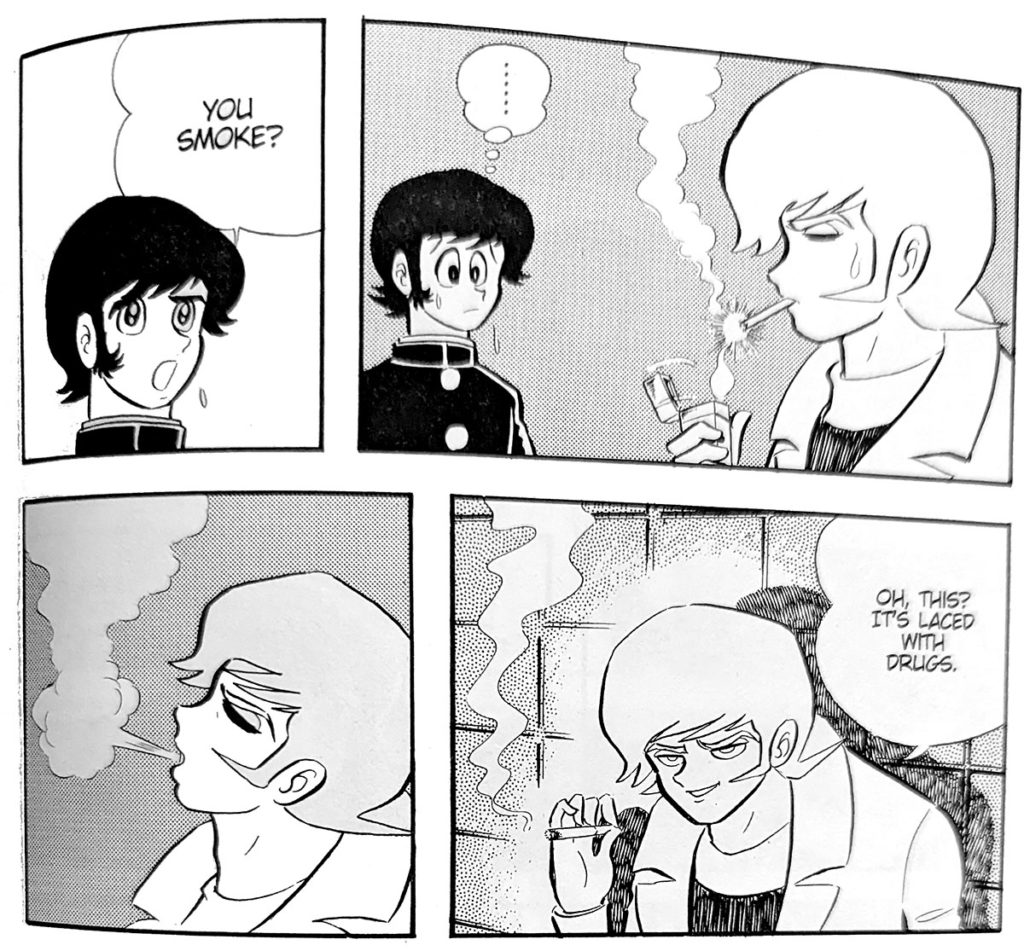
47:00 So yeah, I had to sell a TON of Satanika comics before I started working at the Beguiling, as Verotik’s blurry line between porn and not-porn storytelling greatly appealed to some comic store customers in Canada who couldn’t get real porn comics imported into Canada. So when Sirene made her demonic appearance in this volume (via 1972), the origins of the 1995 character Satanika, created by Glenn Danzig, suddenly became very clear.
I should be VERY CLEAR that I don’t know for sure that there were any legal threats between Go Nagai and Verotik, this is just ‘a story’ for legal purposes. But man, does the timing perfectly line up.
49:40 So when it comes to horror manga, and Devilman certainly has some real moments of horror, to go with the shonen action and the science-fiction, it really recalls the work of Kazuo Umezu (nee: Umezz). His only in-print work as of writing is the recently-re-released Drifting Classroom, which, in its beautiful 3-volume hardcover perfect edition from VIZ Media, is a must-own.
That series features terrible things happening to children in an apocalyptic hellscape, and it also debuted in 1972, the same year as Devilman! The two stand-alone short stories about terrible things happening to little kids in Devilman seem pure-Umezz to me, and while I can’t say that Umezz was an influence on the horror aspects of Devilman with any authority, I can say if you like either story, you’ll find a lot to like in the other.
I also mentioned Umezz’s Cat-Eyed Boy, published by VIZ in two omnibus volumes in 2008, but now badly out of print, as a reference point. Cat-Eyed Boy starts off with the sort of insane energy of Devilman, all of these throw-it-against-the-wall short stories of this little human-looking demon with cat eyes wandering from place to place and terrible things ocurring. Then it evolves into a sustained storyline called “The Band of One Hundred Monsters” that kind of bogs it down. That more-or-less marks the end of the original run. Then after a 10-year break in serialization, the series starts up again for four chapters, which round out the end of the second volume. The art style takes a major leap forward at that point, and it was already good too. Worth noting I just checked and the VIZ edition doesn’t list the Japanese edition or publication history either, though the design and supplemental material does explain some of the history of the character and his publications.
Also, that was 150 words about an out of print book you can’t get. Sorry. There’s a couple of free previews on VIZ’s website though.
For a book that you can get, soon, VIZ is releasing Orochi: The Perfect Edition this year, with volume 1 in March and volume 2 in July. I bought a previous edition of this material and it’s really great girls’ horror manga from Umezz, totally worth checking out if you like Junji Ito’s work, for example, as I believe it was a big influence on him.
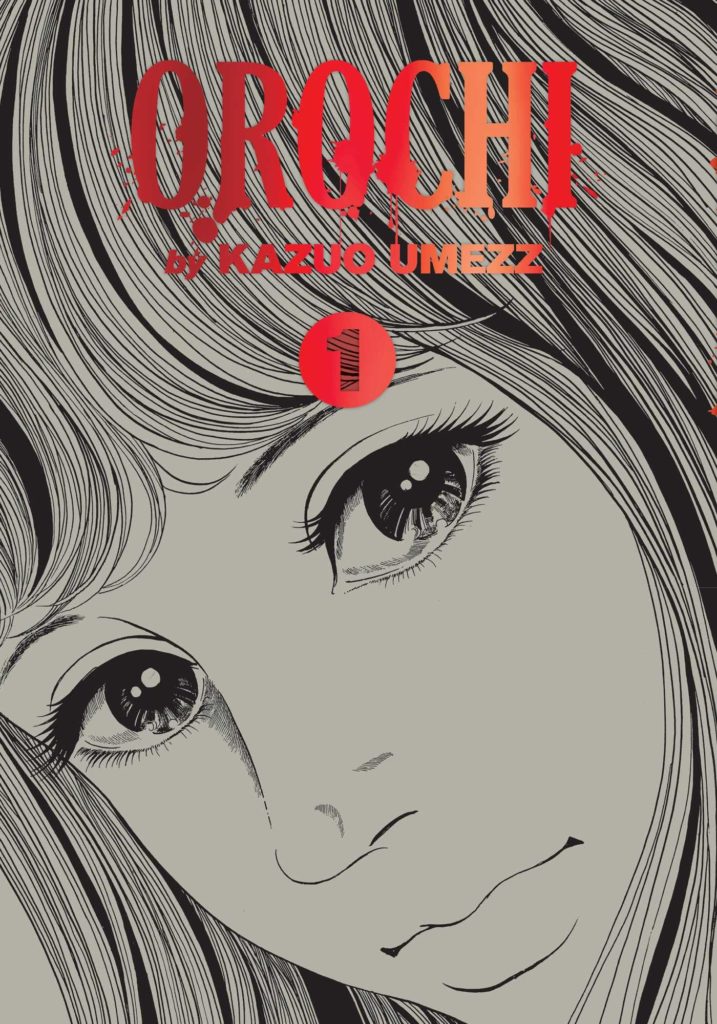
51:00 I feel I would be remiss if I didn’t register the smallest objection to what David says here. While Umezz’s Drifting Classroom does technically end, it doesn’t really have an ‘ending’ per se. Still totally great, and I enjoyed the way it finishes. But it has exactly the same ending as the Nausicaa manga.
53:20 Oh man, I’ve been working on this for 7 hours at this point, slow going and lots of research this week, and then Deb had to go and mention Candy Candy, Tiger Mask, and F, the formula 1 racing manga. Luckily, I love Deb, so let’s do this!
Candy Candy is a classic shoujo manga by Kyoko Mizuki and illustrated by Yumiko Igarashi, that ran from 1975-1979. It’s about a little orphan girl who deals with many trials in life (including getting taken in by new adoptive parents, treated exceedingly poorly, and then returning to the orphanage). It was incredibly popular at the time, spinning off a television anime that aired around the world, as well as animated films. Due to ‘legal issues’ between the original author, the manga illustrator, and the animation company that produced the anime, the work has not been legally published in any format since the early 1990s.
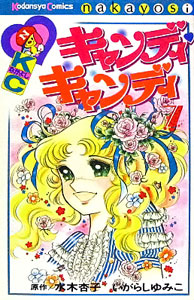
Tiger Mask is a manga series by Ikki Kajiwara and illustrated by Naoki Tsuji, first published from 1968-1971. The series follows an orphan (themes!) who grows up to become a ‘heel’ or villainous professional wrestler, recognizes the error of his ways, and seeks to become an inspiring heroic professional wrestler… who also fights off a shadowy evil organization filled with assassins… in and out of the ring! The character got a very popular anime series around the same time, and the New Japan Pro-Wrestling organization also licensed the use of the character to create a real-life Tiger Mask wrestler in their federation, and the character continues to this day with many different wrestlers portraying him. Like Candy Candy, the animation was widely distributed into different languages across the world, and its a character who has huge international popularity while being relatively unknown in continental North America, where it has not been published (though there have been some anime featuring the character released to home video).
Just between you and me, I can’t understand why no one has picked up any of the Japanese wrestling manga.
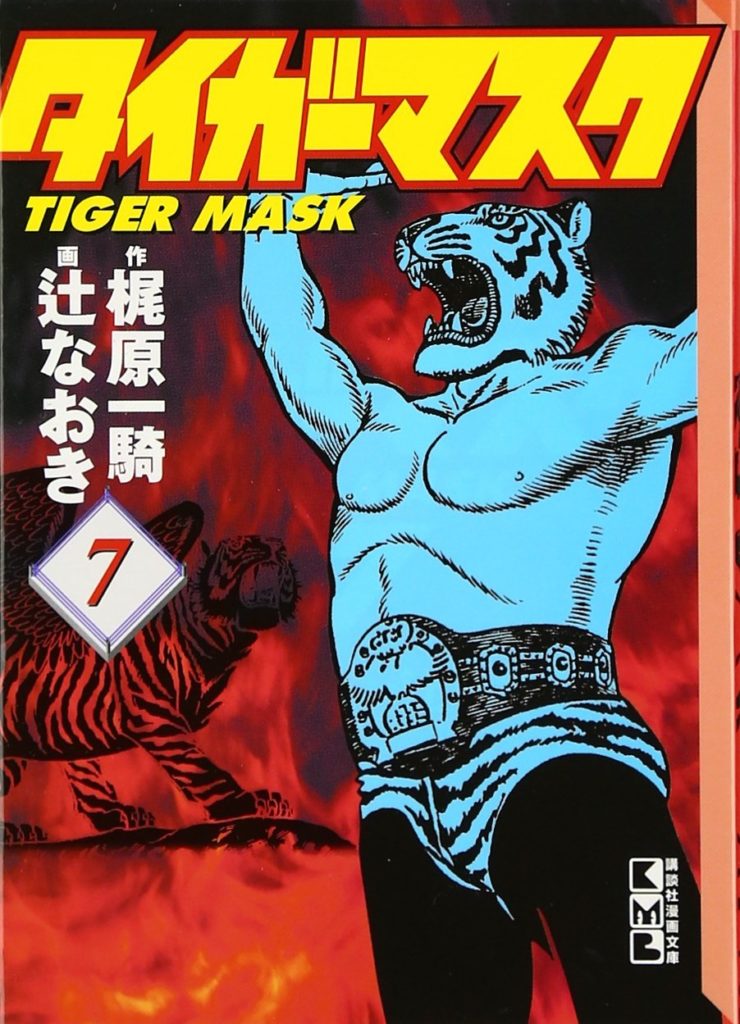
Finally, Deb mentions F, a Formula 1 auto-racing manga by Noboru Rokuda, and published in seinen manga magazine Big Comic Spirits from 1985-1992. I actually don’t know anything at all about this one. Apparently it has ‘interesting’ ideas about ditching other driver? Lol. Maybe Deb will fill in some details.
[Deb:] F is probably the most jaw-droppingly crazy seinen sports manga I’ve ever read. It’s about a rebellious guy from the countryside who has a need for speed that takes him to the world’s biggest racetracks as a Formula One racer.
It’s available in English (albeit as a digital-only release, and I think it’s unfinished at 20 volumes) on Comixology as part of its Unlimited subscription, so sure, I binge-read the heck out of it. However, It’s not for everyone — it’s got several scenes where female characters… well, let’s just say it… they get raped. There’s also this scene from volume 1, where Gunma, the hero of the story is so determined to win a no-holds-barred street race, he decides to sabotage his rival by dropping a load on him from his car’s busted rear window. It’s… crazy like that. Anyway, if classic manga is your thing, F is an interesting glimpse into what was being published around the same time as Devilman.
55:30 I think Deb’s got a good point here about how Japanese mainstream material is just way, way crazier (or at least it was) than what was available at the same time in North America. Our puritanical roots are showing, eh? I was gonna jump in here and mentioned that comparable material WAS being made in the U.S. at the time, but in the adults-only “Underground” comics market. Go Nagai’s Harenchi Gakuen ran in, I shit you not, Shonen Jump, in the 1960s. Wild. And it’s worth noting that the Underground, made by and for adults, were still the subject of intense persecution.
56:30 Rosemary’s Baby debuted in 1968, Black Sabbath debuted in 1970 (man, someone needs to ask Go Nagai about the influence of Black Sabbath on Devilman), the Satanism scare with Dungeons & Dragons in the mid 1970s. So much stuff around this period, part of the cultural zeitgeist and the follow-up to the peace-and-love late 1960s hippie movement.
58:50 Let’s leave Devilman Classic Collection Volume 1 on this image, which sums up what this manga is really all about: MANLY TEARS!
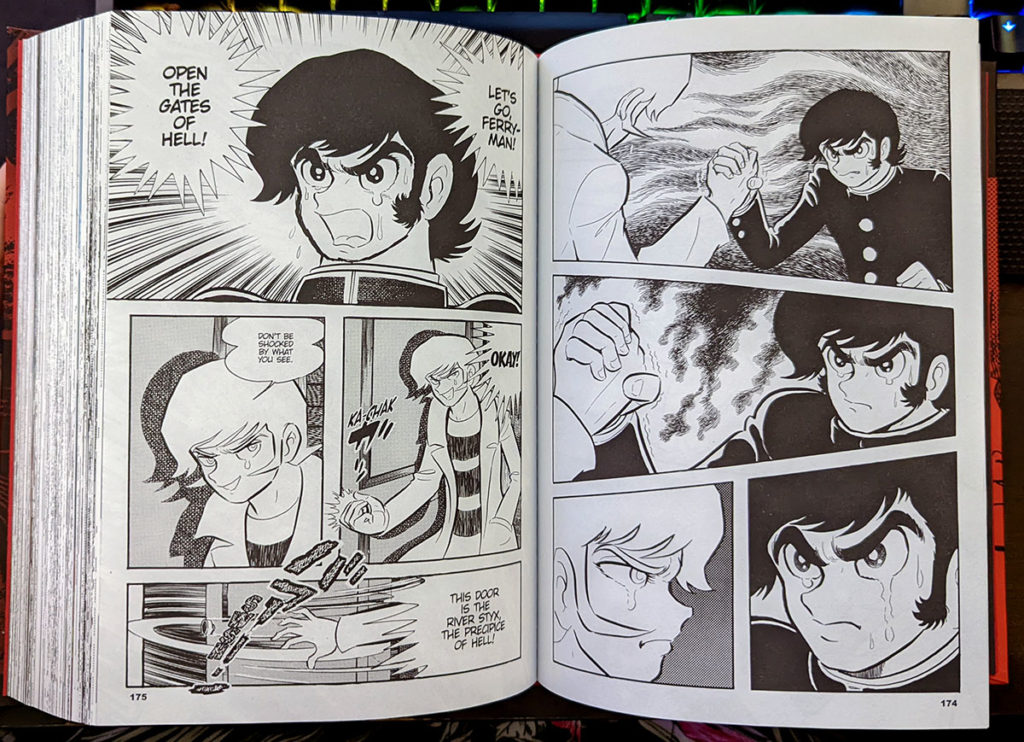
59:50 THE BREAK! You might get an ad here, you might not.
It’s time for some reader Q&A!
I’ve just caught up through all the episodes of the podcast, and now I’m really looking forward to hearing you talk about your first alt-manga/small press comics in An Invitation from a Crab by Panpanya. Do you think you will be able to make space in the podcast for more art manga or less highly commercial works? Especially with the recent crop of English-language small press manga publishers that have popped up in the last year like Starfruit Books and Glacier Bay Books (which just won an Ignatz for it’s stellar Glaeolia manga anthology), North American readers suddenly have a chance to read works from authors they would probably never be able to without going to COMITIA. I, personally, would love to hear you talk about these types of works!
And by an alternate coin. Do you think you’ll ever cover manhwa or “”webtoon-style”” comics. How far does the term manga stretch for this podcast? “
Carina Taylor, in E-mail.
Like we said on the podcast, we’re open to talking about any kind of manga, but we’re all involved in the comics and manga publishing industries to some degree, and we all want to be good and supportive folks, and we’re going to have to choose titles that let us feel good about doing the podcast. 🙂
Meanwhile, Deb references the Manta Webtoons App as being particularly attractive to her as a reader who wants to know more about Korean Comics and Webtoons, because they offer a flat monthly rate for all-you-can-read webtoons. https://manta.net/
David references the Japanese light novel and manga series My Life as a Villainess: All Routes Lead to Doom!, one of the ‘better’ examples of the isekai light novel genre. Also published in English by Seven Seas.
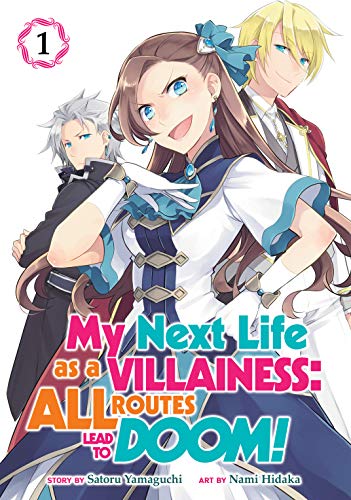
Christopher references Guyabano Holiday, by Panpanya, the next book (coming June 2022) from the creator who gave us An Invitation From a Crab, which we covered earlier this season. Published by Denpa.
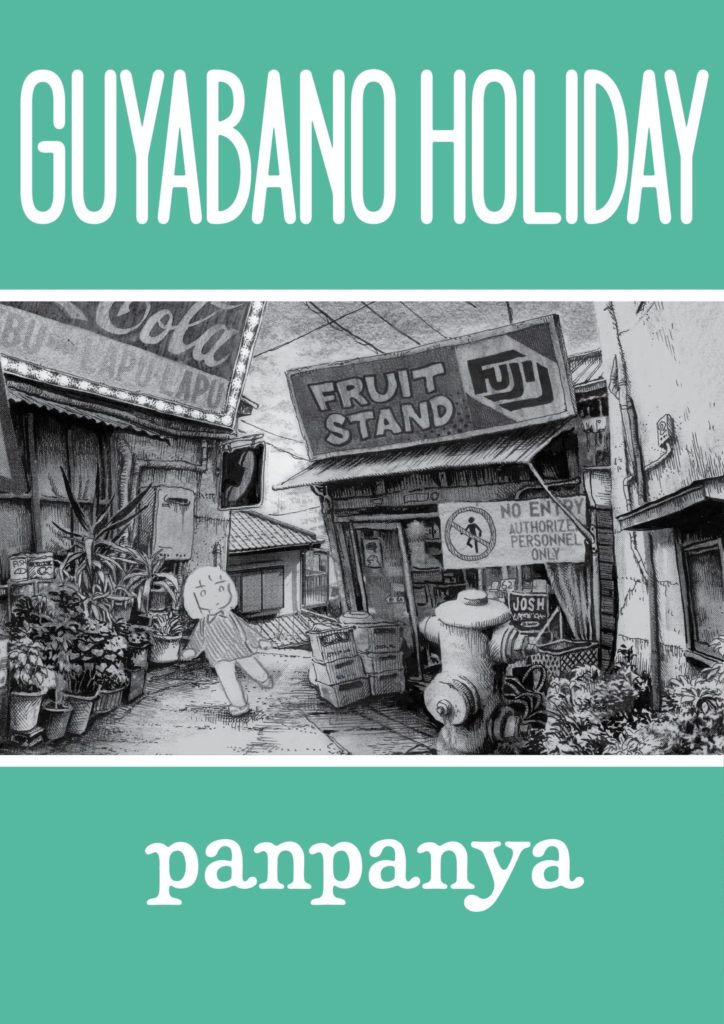
…and then we talk about Devilman some more, because yeah, there’s… a lot to say. Haha.
[Deb:] Just because I can, here’s some photos from Go Nagai’s visit to Anime Expo in Los Angeles in 2018.
Thanks so much for listening to this episode! Remember to check out your local comic and manga specialty shop for all the great books. Find one near you at comicshoplocator.com. You can also check out your local library for print and digital lending options on a wide variety of manga. And as always, thanks to D.A.D.S. for their musical accompaniment this week, and we’ll see you again next time! Take care!
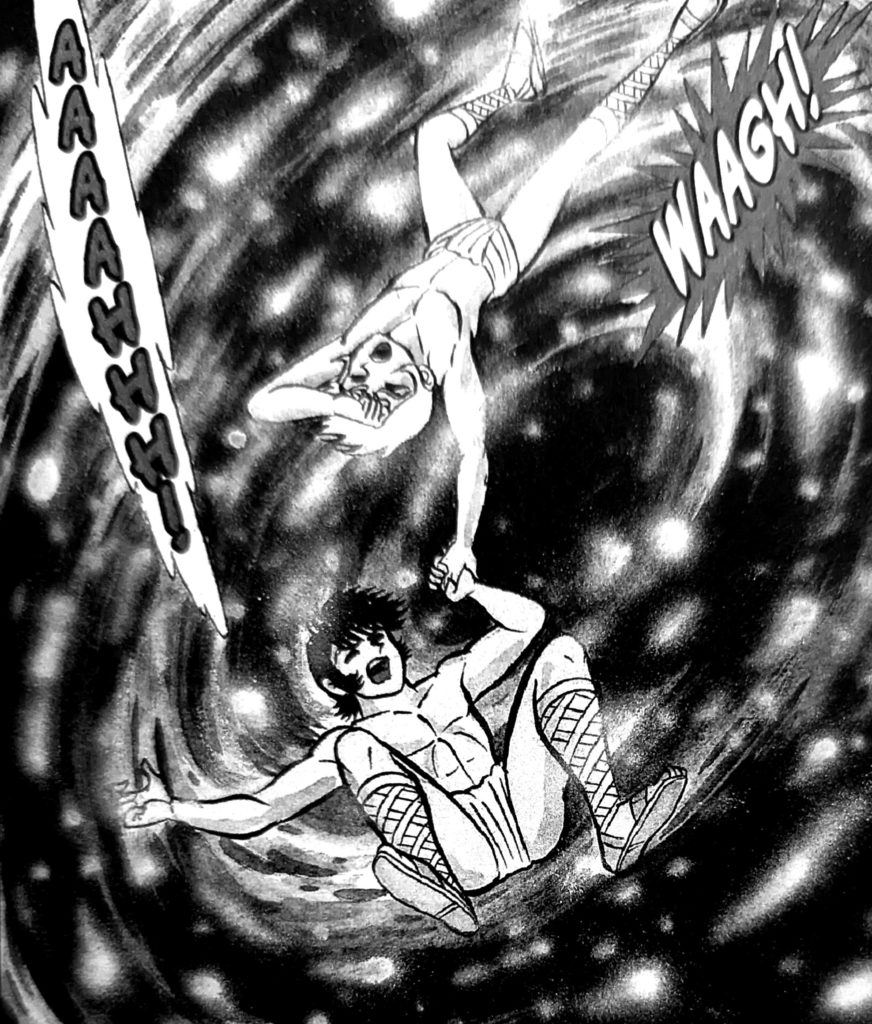
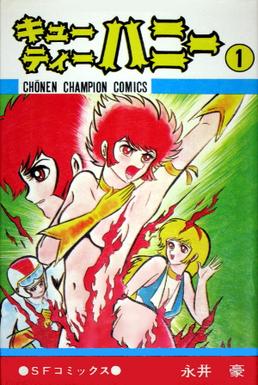
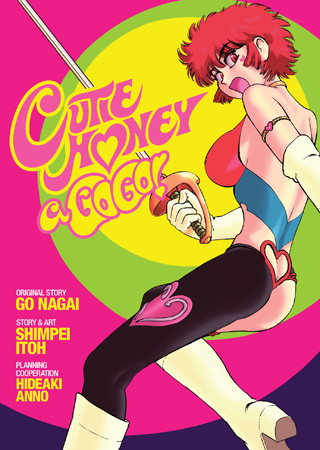
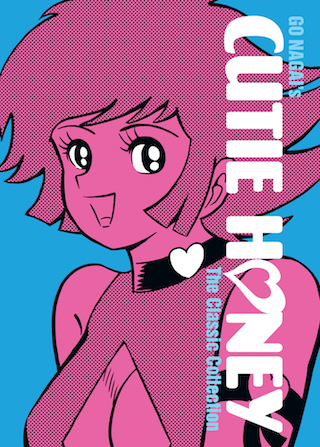
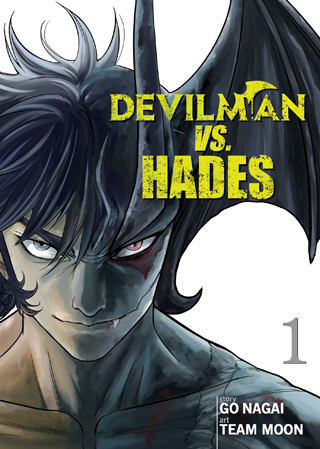
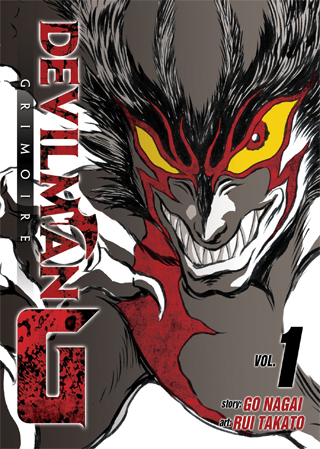
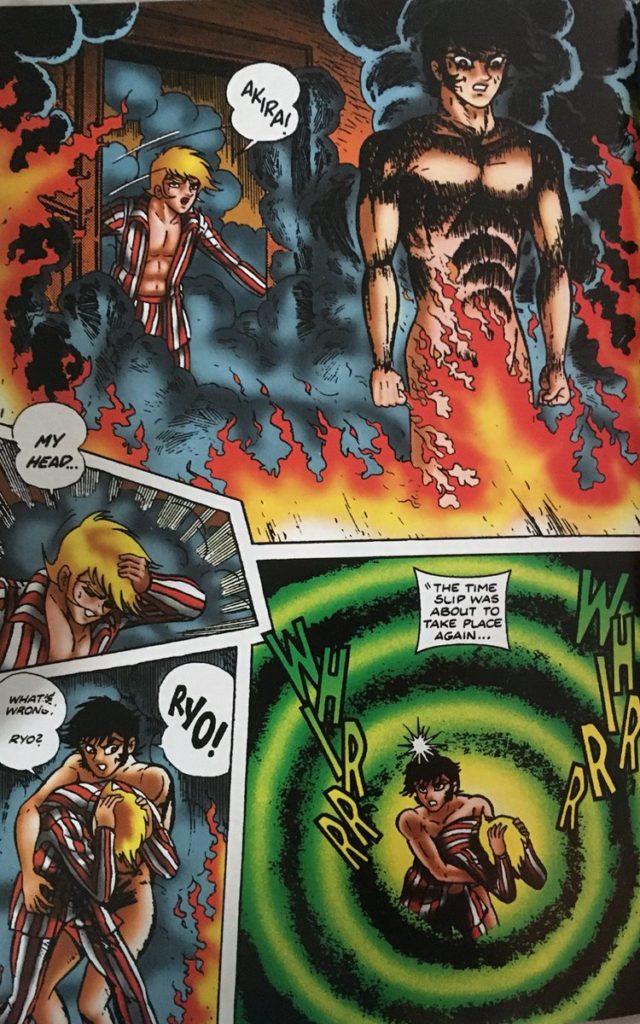
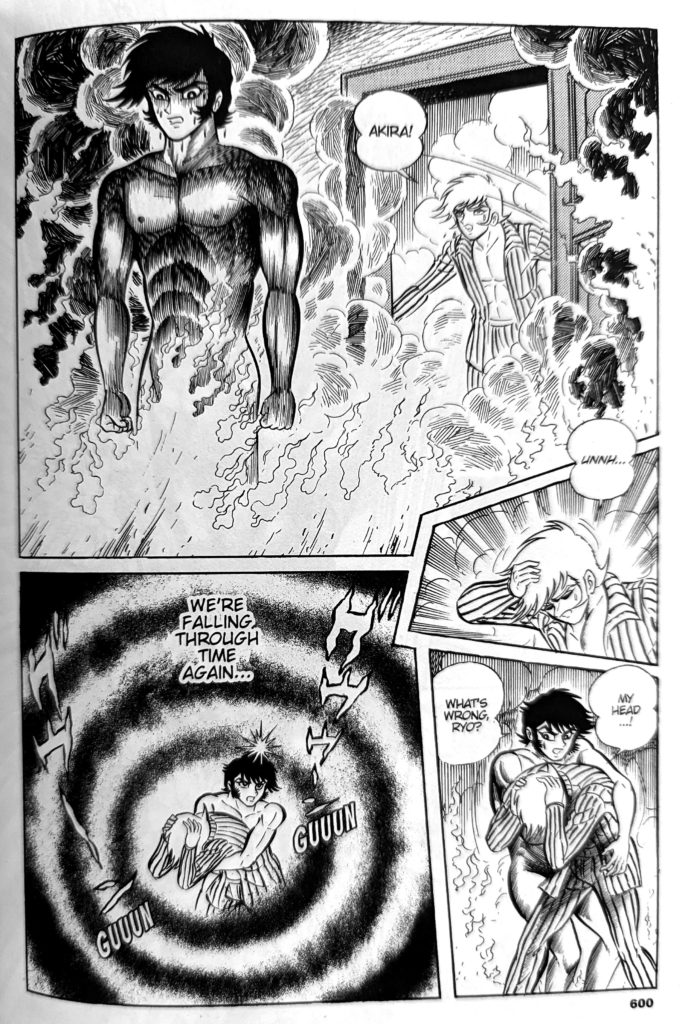
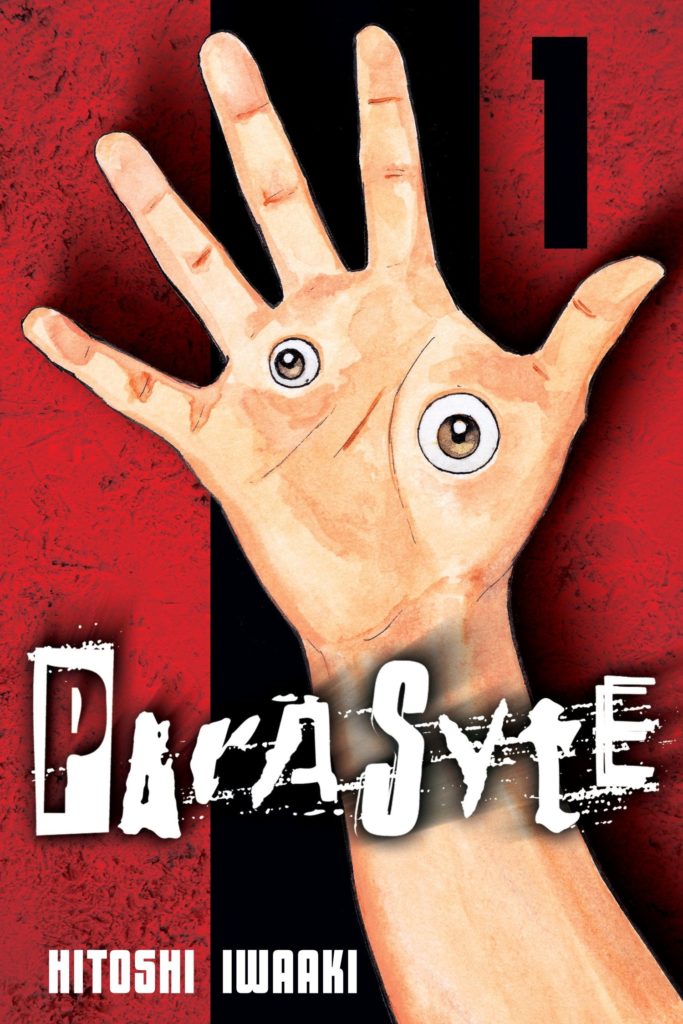
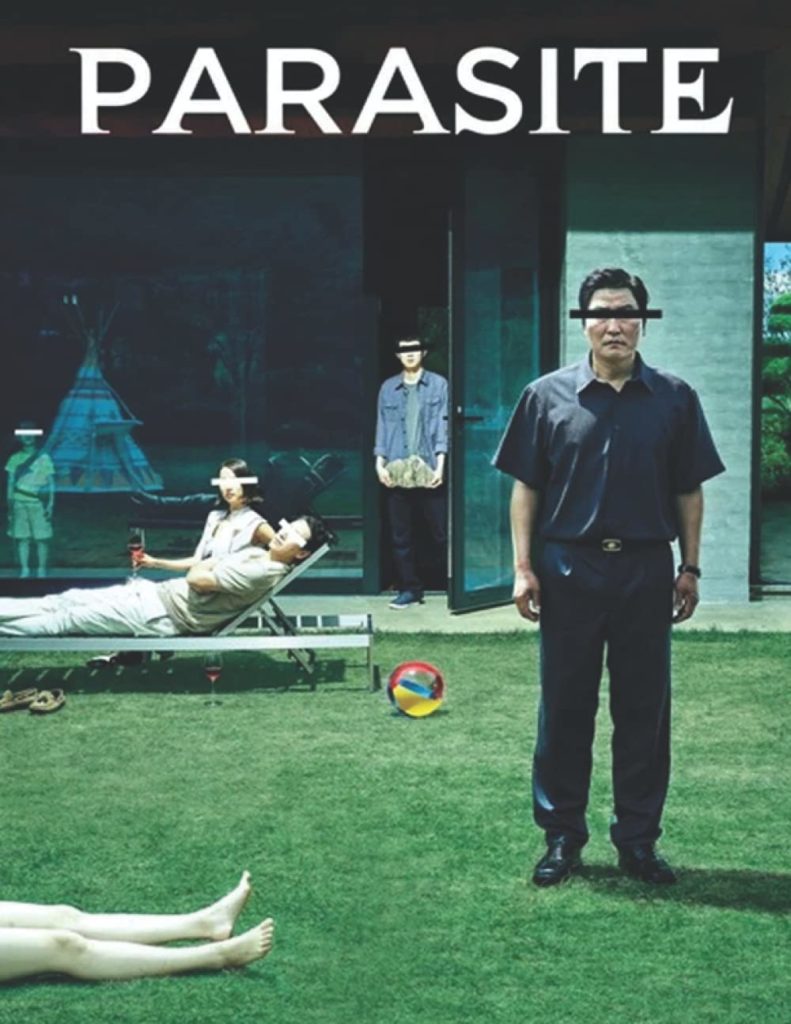
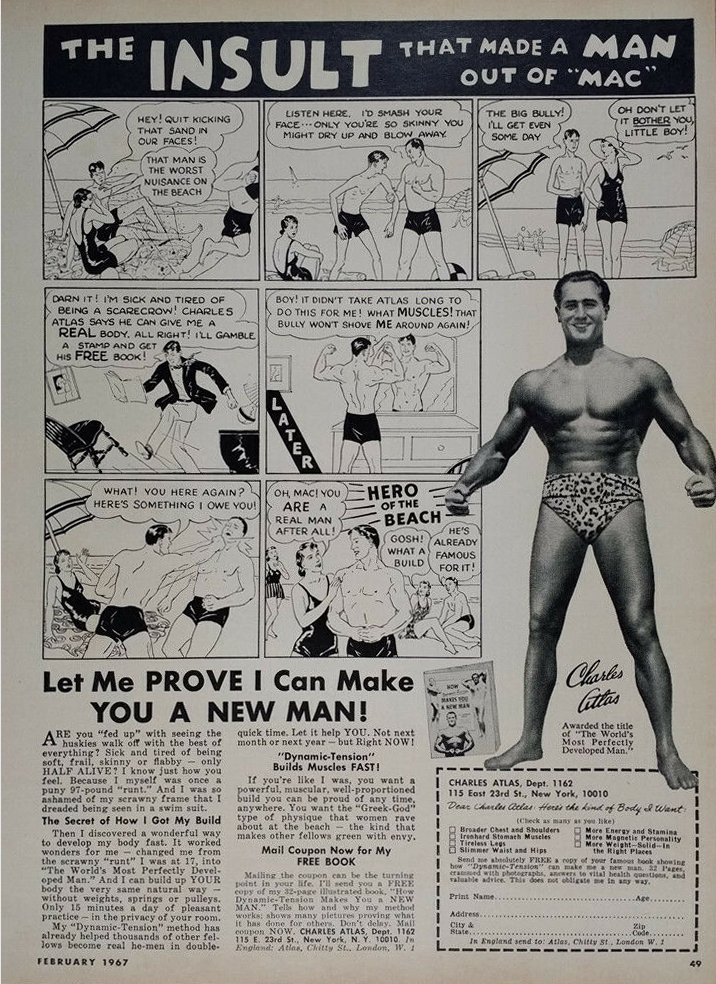
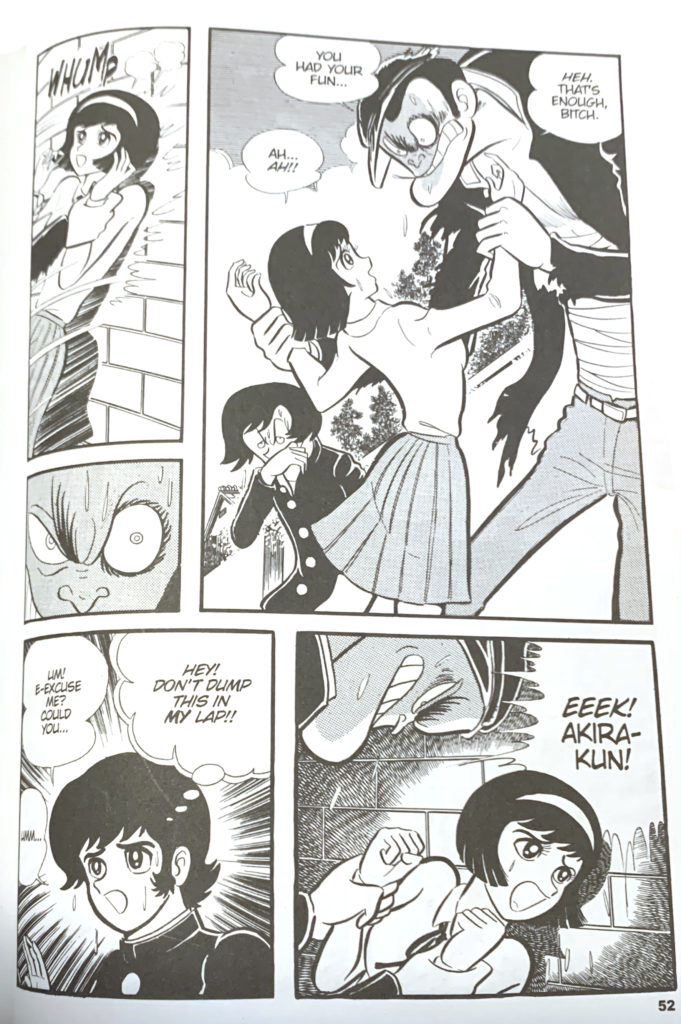
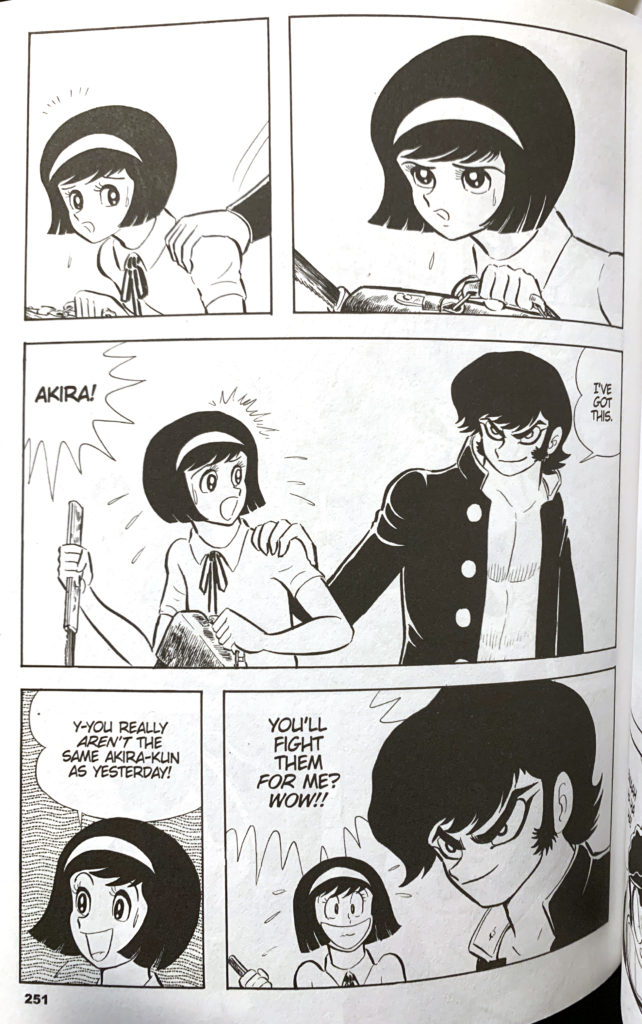
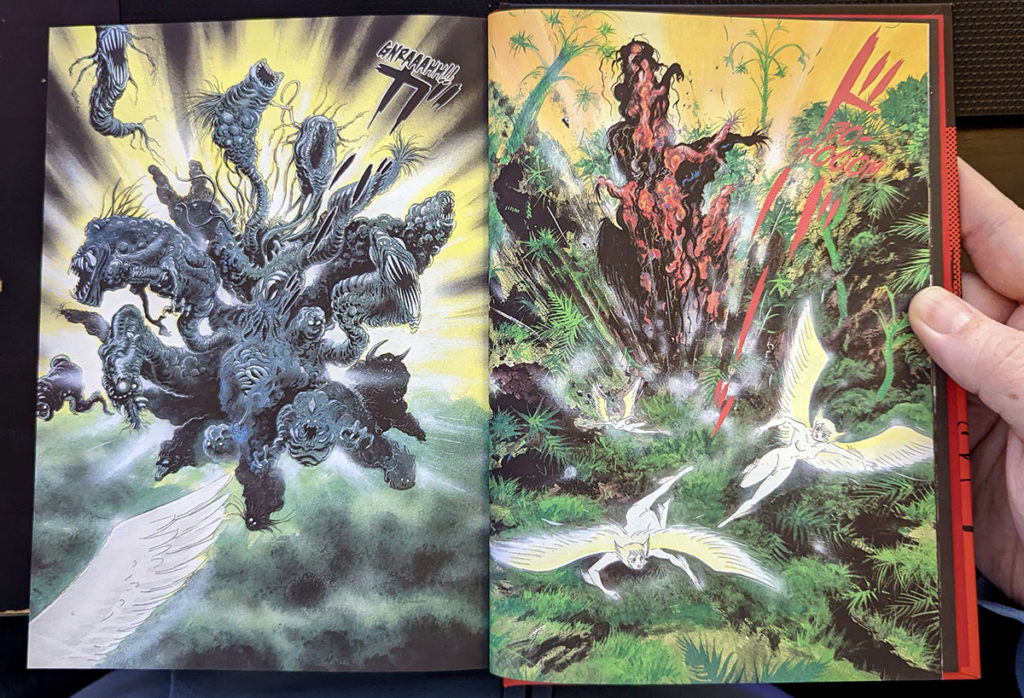
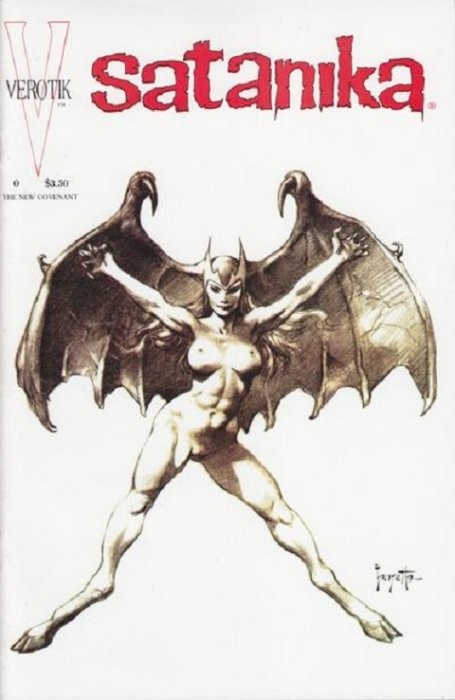
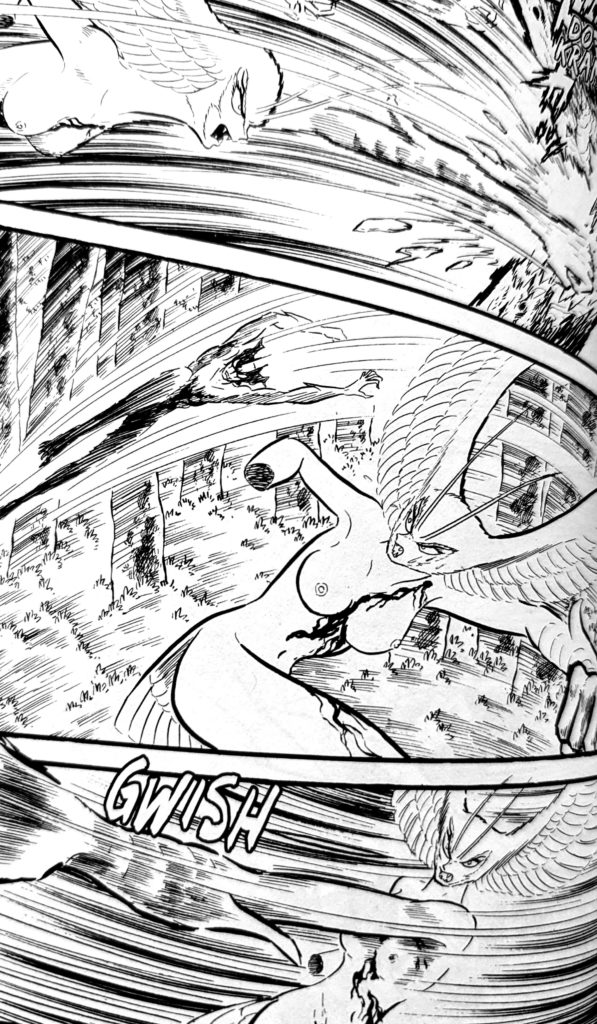
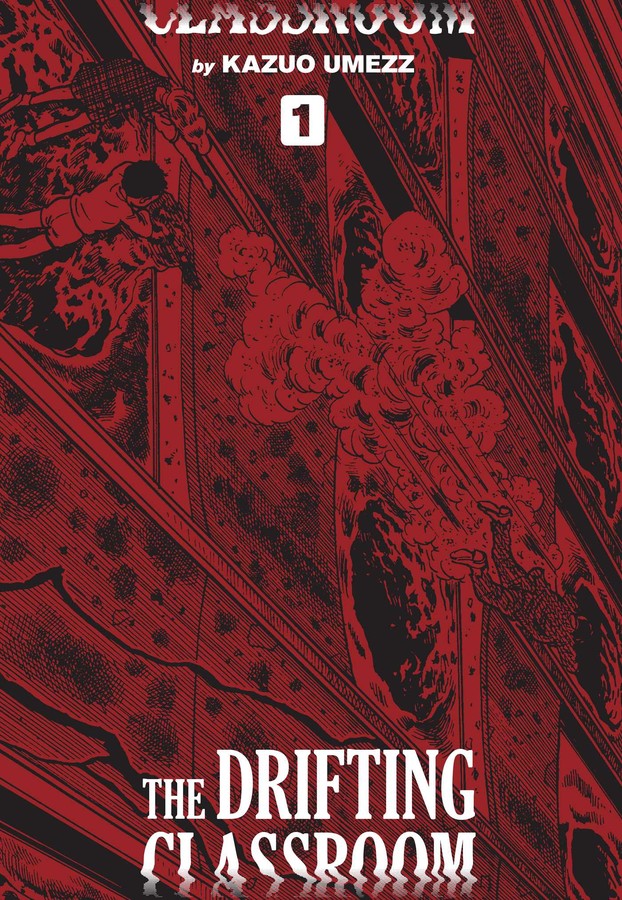
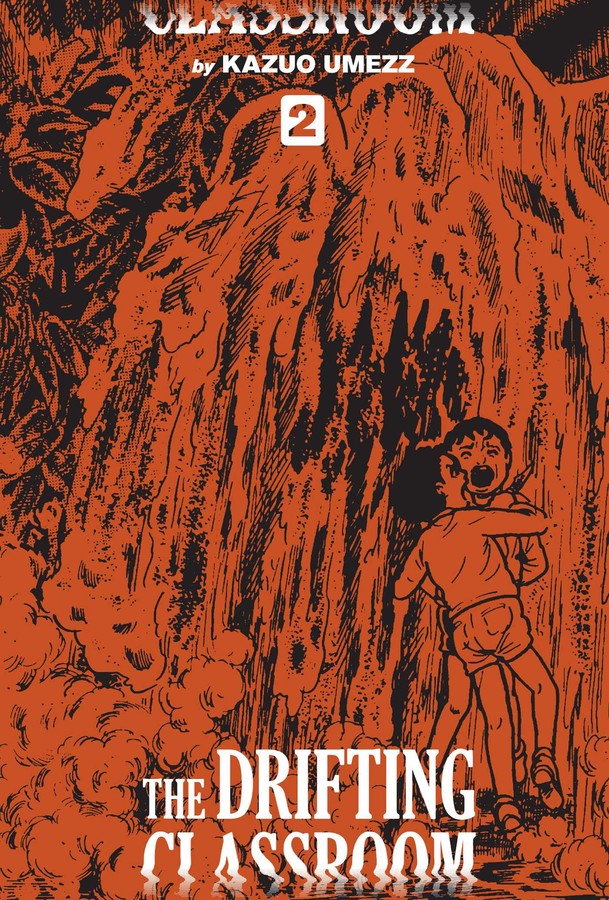
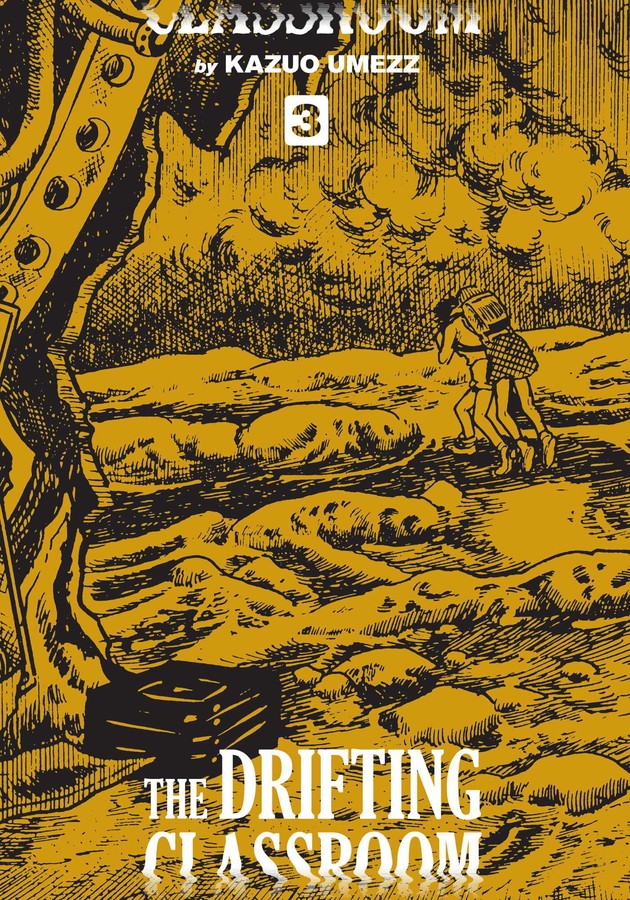
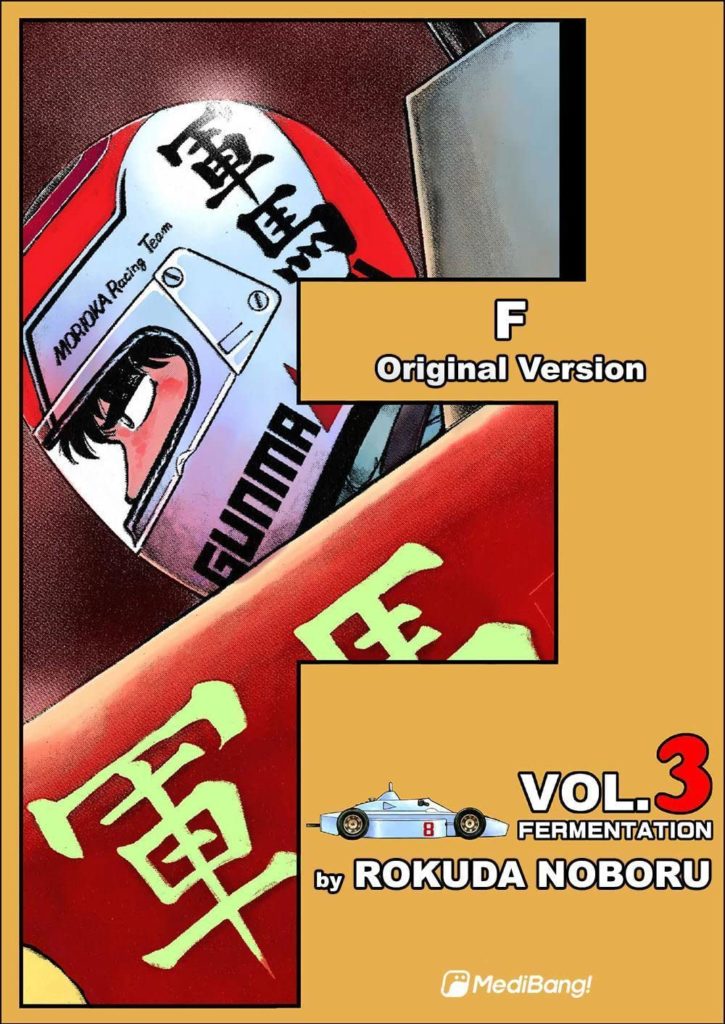
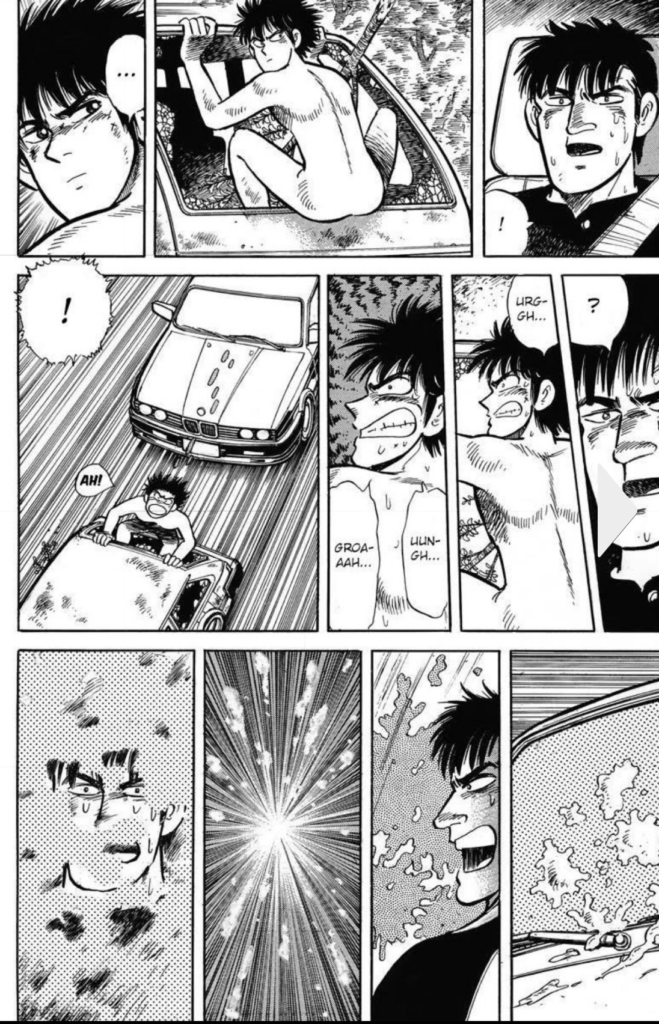
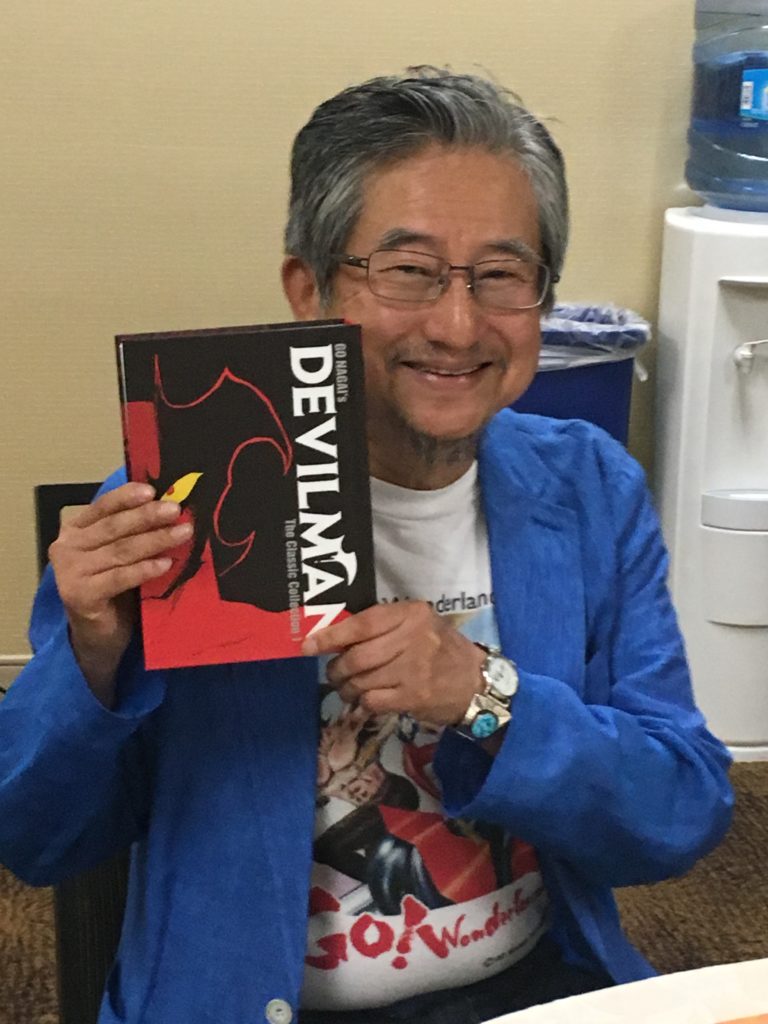
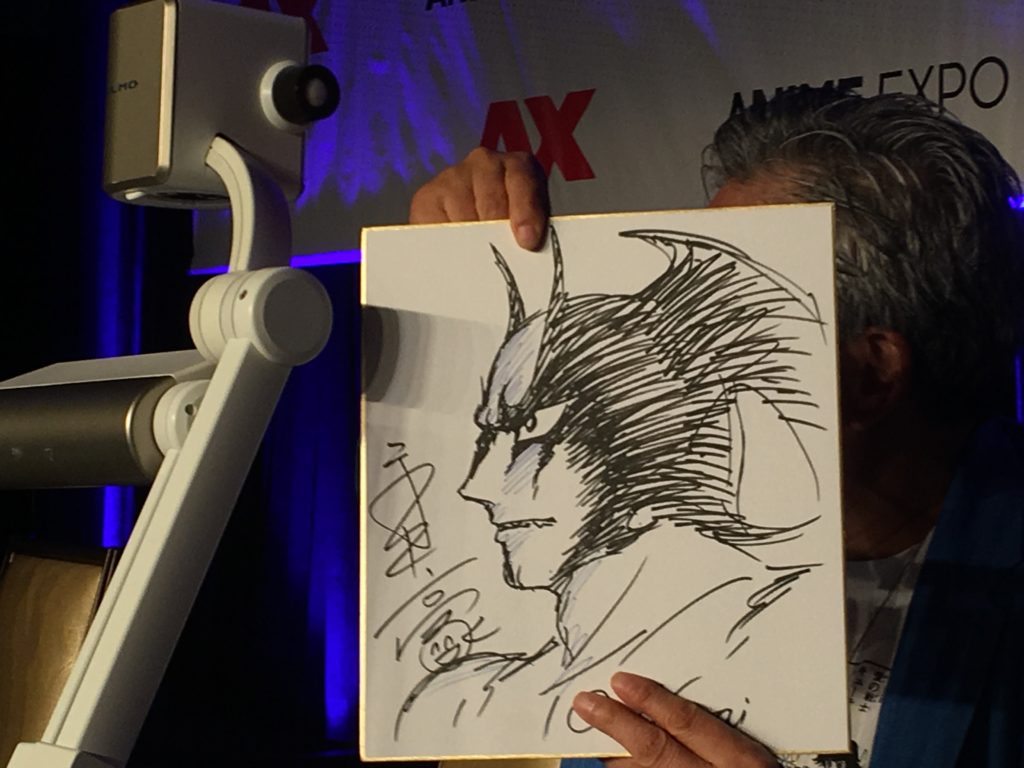
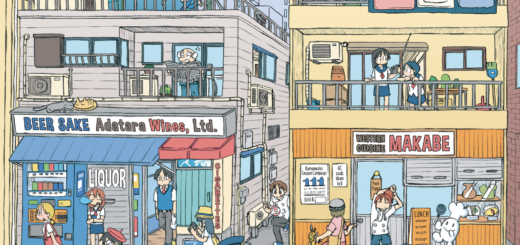
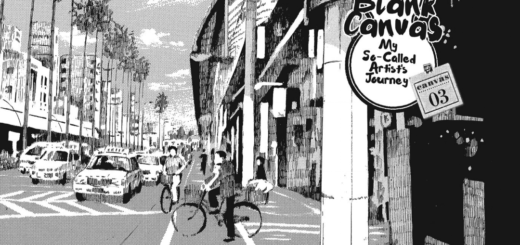
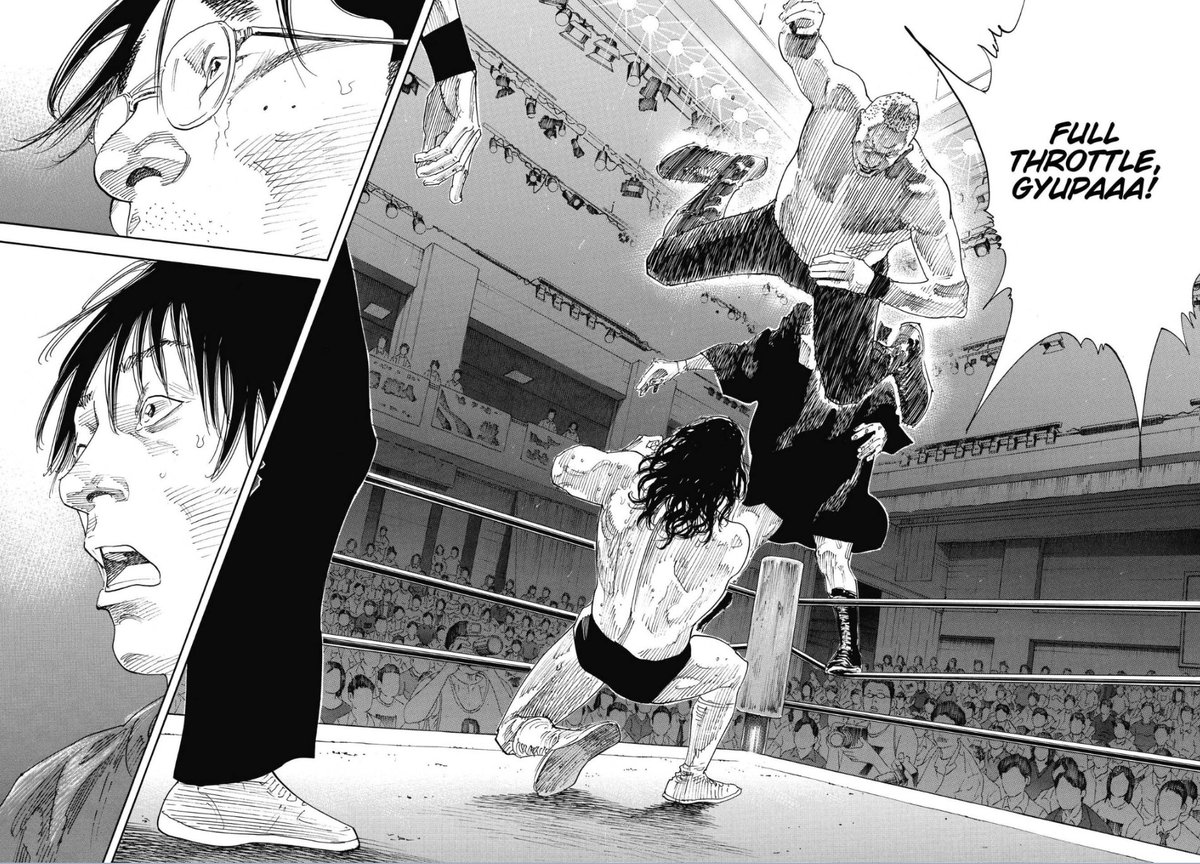
Wow–I think this is the most impressive show notes yet–great job and fun (as always) podcast. As has been obvious in my posts here, my jam is vintage shoujo, not so much shonen, but I had to pick up both this and Cutey Honey when they came out, as I’ve been fascinated by Go Nagai ever since I read my first book on manga, back as a young buck in the early 90s, Schodt’s Manga! Manga! (at the time maybe the only book on manga?) which covered Shameless School in some depth.
Actually, lately I realized how much reading and re-reading Manga! Manga! influenced my taste in manga and what I’ve collected–at least vintage wise. And since, of course, I have to bring shoujo classics into this, that includes the fact that they had a long excerpt from Rose of Versailles (and not long after I found the two English volumes Schodt translated for Japanese students learning English of RoV, prob the rarest books in my collection.
So I’m thrilled that you all will cover Rose of Versailles eventually (and I still kinda can’t believe we finally got it in English–to read it all before I had to get the French omnibuses), but I’m gonna be obnoxious and disagree with one of Christopher’s quick comments that Rose of Versailles “even aged-up the entire genre from a children’s genre to a teen/YA genre. ”
That actually pretty inarguably happened three years before Rose of Versailles (and maybe arguably even earlier) with Seventeen magazine deciding to publish shoujo manga that skewered a bit older than Margaret and other magazines with 1969-71’s Hideko Mizuno masterpiece Fire! which has been a true obsession of mine since, well, since I saw a page of it in Manga! Manga! (see, it all goes back to that) which showed the first shoujo sex scene (much more explicit than anything in Rose of Versailles).
Fire! was a phenomenon (albeit not quite on the level the much longer Rose of Versailles would become), got a lot of attention from non shoujo readers, and, years before the Year 24 mangaka really made an impact, dealt with the kinds of subject matters and issues that they usually get credit for originating (including focusing on male characters). In fact it was not only a huge influence on Moto Hagio and Keiko Takemiya, but I just read an interview with Riyoko Ikeda where she said it inspired Rose of Versailles directly because she realized she could also deal with similar themes of non conformity and uprisings against the establishment, and she modeled Oscar’s image directly on rock star-god Fire Wolf from Fire! (well combined with Tadzio from the Visconti film of Death in Venice.)
Oh and I have to say, for some reason the only imagery in Devilman that really grosses me out is that whole turtle section which starts to go edge towards the body horror of Ito (though the anime Devilman Crybaby had a lot of imagery I found hard to watch–but I can be squeamish).
(And another side note–as a kid in French immersion in Alberta and then BC from preschool on, we were allowed to watch much more TV if we watched it in French–one of my fave series was Candy Candy)
And I’m glad to see some Kazuo Umezz discussion come up as I am a big fan (though, to nitpick, Orochi isn’t technically shoujo–it was serialized in Weekly Shonen Sunday, though it does have some vintage shoujo horror vibes for sure). I was particularly obsessed with the craziness of Drifting Classroom when Viz first released it–as you mention in this Devilman discussion, anyone who thinks that only vintage shoujo had the melodrama and emotions at full force hasn’t seen shonen manga from that time (the tears and emotions are just more manly–or something).
Drifting Classroom is also notable (at least to me) for its bizarre live action adaptations–the best is the 1987 one from Nobuhiko Ôbayashi who directed the gonzo Japanese classic House. This isn’t on that level (no people eating pianos!) but is just so bizarre, including the school becoming international which means they use some English language cast members–including Troy Donahue (!!) as a teacher. Then there’s the 1995 version from Junichi Mimura, made for a Japanese audience but oddly with an entirely English language cast–including future Disney TV star Drake Bell. There’s also a romance focused J-Drama series… that manga is just the gift that keeps on giving. Cat Eyed Boy also has a kinda fascinating adaptation with a recent horror movie–but more interesting a 1970s anime TV series that used painted images that only… sorta are animated (but a great theme song).
Christopher’s words really resonated with me this episode. Like for him, “The Classic Collection” gave me the impression that it collects the original, and I was surprised to learn that it doesn’t! I have a perspective on this informed partly by volunteering with archivist groups, and partly by my experience working as a translator, so I thought I’d share.
When I read manga, it’s not only as entertainment, but as a form of cultural and historical education: it contributes to my understanding of a different time; a different place. This goes triple for releases of *old* manga – as Christopher put it, readers who pick up a book like this don’t do so in search of something as exciting as Jujutsu Kaisen! Rather, these English translations become the West’s canonical historical image of what the original work fundamentally is. If the content represents something else, then, that’s misleading – unintentionally so, but misleading nonetheless – to the uninformed reader (and perhaps even to our collective image of the work’s place in history), which is a shame.
The way around this, of course, is to annotate, explain what’s what, and provide the context the reader lacks! Movies have the Criterion Collection, and music has liner notes – manga can too (and has, in series like Oishinbo). I dream of a future in which publishers realize that there’s no such thing as too much context.
“The way around this, of course, is to annotate, explain what’s what, and provide the context the reader lacks! Movies have the Criterion Collection, and music has liner notes – manga can too (and has, in series like Oishinbo). ”
Samuel–a thousand times YES. This came up in the A Drunken Dream episode–where Fantagraphics, who really should be depended on for giving some historical context–only provided the most recent copyright date for each short story included which caused some confusion. As I said in the comments there, a significant number of people then actually thought some of the older titles were actually some of the newer titles (despite the fact that in the volume you can clearly see a progression in Moto Hagio’s work if you know the proper chronology). In the case of Drunken Dream, some context as to the fact that the different stories were from different magazines that targeted significantly different demographics, would have also been welcome. And Fantagraphics still always includes translation notes, and other pieces of information, so I’m not sure why so far with their manga releases they haven’t thought to include the actual publication context.
I’ve actually argued about this with a manga translator who thought I was making too much of a big deal that most English manga can’t even, at the least, make a tiny note about where and when the original manga was published. VIz, for example, rarely does. Some publishers are good at this–Denpa always has a note about the magazine and dates of the original serialization. And the Udon release of Rose of Versailles even gives the original publication date (down to the week) of each chapter.
As you put it so well, the problem with this lack of context is it then becomes canonical among English fans to assume that they are reading something that… well they aren’t.
The “creepy uncle of manga” I’ve been saying that for years. ^_^ It is my opinion that Nagai has a life goal to do everything Tezuka did, better than Tezuka did it. Man, I’d love to write that essay, because I am a huge fan – I went to the 50th anniversary exhibit in Tokyo and it was so impressive. He’s even done a Dante’s Inferno. Nagai’s got his oeuvre and he’s a genius at it. This is the early days of his delving into his obsession with demons, but he just gets better and better. The exhibition was so impressive, honestly.
Gonna also recommend Devilman Crybaby. It was an outstanding collaboration, between Yuasa’s trippy art and Nagai’s trippy narrative.
I live in hope that Devilman Lady get translated because it’s a whole story and still completely bonkers. I love it so much. The ending is completely batshit. ^_^
Your Tezuka comparison is something I’ve never thought of before–and I love it. It strikes me as completely spot on (come at me Tezuka fans :P)
I agree about Devilman Crybaby. In the past, I’ve not really been a fan of Go Nagai anime adaptations (though the 70s Devilman and Cutey Honey animes, despite turning the narratives into formulaic, episodic works, undeniably have some retro charm) but Devilman Crybaby is really how to do a modern adaptation/re-interpretaion of a classic, right.
What, no “Hitler! Adolf Hitler!” screenshot? I thought these show notes were supposed to be exhaustive.
Hey Christopher here. Thanks for this comment, that image is supposed to be in the show notes and it looks like it got deleted accidentally. I’m adding it back in now…!
And just to be clear–Erica Friedman can confirm this–but the Udon release of Rose of Versailles does NOT do what Christopher in this podcast thinks it might do (and what this Devilman does). Wisely it’s based on the edition of from Japan that sought to be the most authentic presentation of the manga– Unlike even theoriginal Tankoubons, it puts back in the chapter breaks as it was published in Margaret Magazine (complete with giving us the date of each chapter) and everything is in serialization order–the one 1974 and several 1984-85 side stories (gaiden) are at the end of the fifth volume, where they should be even though they chronologically take place earlier. And we’re getting the final (?) 2013-2018 side stories from Udon in one or two new volumes sometime this year. As well the majority of the special magazine and promo art is (mostly) also included between the chapters of the time it would have been published (and there’s always a credit as to where it was from). This is above and beyond *anything* I’ve seen done with classic manga in English before (sorry Fantagraphics and your beautiful Hagio books that fail to give any publication context…)
As someone obsessed with how these classic titles were originally serialized, I was thrilled by this (my French editions follow the Japanese Aixoubon volumes that tell you where each tankoubon would end, but not where the original chapters were). For one thing, since it was a weekly manga, the chapters are short and each has its own flow, always ending on a climax–when reading this without the chapter stops, that seems a bit like poor storytelling and a bit unrelenting, but in this context it makes a lot more sense and you see how brilliantly constructed it was (in the case of RoV–I’m not sure anything could make you feel Devilman was brilliantly constructed).
So it’s not similar to these Classic releases from Seven Seas (I think their Matsumoto vols have some of these same issues) at all. But, as Christopher does point out, Seven Seas is just going by the editions the Japanese publishers put out and gave them (and probably the one Go Nagai likes best) and I’d be curious if they even knew about the differences.
(Denpa is releasing Hagio’s They Were 11 later this year, as you know–but I’m a bit iffy on the edition they’ve been given to license. It’s the deluxe edition from Japan with beautiful colour pages, and with the sequel series which I like even more than the original serial, BUT it leaves out the brilliantly funny Space Street comic mini-series that Hagio wrote between the two longer serials and most of the other Japanese editions contain. I even asked Denpa about this, and they confirmed it. But–I don’t think there’s much that can be done, beggar’s can’t be choosers, etc etc.)
The discussion of reprints of manga that present things out of order reminded me of the Astro Boy and Black Jack collections that have been released in English. Neither is in anything approaching chronological order, but rather is (apparently) in the order that Tezuka wanted them to be collected. (Though I’m sure I remember something about how he chose stories he liked that hadn’t been collected before to go in the early volumes because he just wanted them to be collected.)
The first 15 minutes of this episode had some of the funniest comments on this show yet. There was a very nice comedic moment when you all realized you did not love this book that had me in tears. (Which was pretty dangerous because I was on my bike at the time.) So when you got to the part about color pages with angels and demons, I was a bit nonplussed, but thought nothing of it. Then you started talking about time traveling, and when Chip mentioned Hitler in his inimitable deadpan delivery, I completely thought he was taking the piss. Thank God (Can you say that in a Devilman podcast comment?) Chris looked at the scanlations (using evil for good purposes!) and helped set me straight. The show notes also helped with this.
So the Japanese version I read is a 1000+ page collection of the ORIGINAL series, no Shin Devilman. It was published as a nice hardcover omnibus in 2000 by Futabasha. (You can see it what it looks like here: https://aucview.aucfan.com/yahoo/k174815896/) The only info on the material is an indicia explaining where the series originally ran. Guess I’ll have to hunt up Shin Devilman now.
All your observations about the book are spot on. I enjoyed reading it, despite kind of knowing where it was going thanks to watching the OAV series in the ’90s, on VHS no less. The pacing all throughout is just terrible, and Ryo exposits plots like nobody’s business. (Well, I guess that should have been Nagai’s business.) I can’t believe how little of Devilman himself there is. Imagine Sailor Moon with very little of the Sailor Scouts? Or The Dark Knight Returns where Batman is conspicuous by his absence? That’s what this felt like, and very much at odds with the TV show that adapted it.
Shout out to Erica, because I too thought that Nagai is the kind of the anti-Tezuka, or at least the reverse to his obverse. There’s a frisson to many of the pages, even though the vast majority of them are lacking in backgrounds of any note, not even a shadow or a line to indicate a wall in most of them. Although I do love when Akira and Ryo are having an entire conversation in the dark and you only see the white of the their faces. Some definite moody stuff in here. Some of the drawing that look just like charcoal etchings suggesting a form rather than having form reminded me of some of the best Bill Sienkiewicz.
All in all, lots of WTF moments in here (the little girl who came out of nowhere just to die on the turtle demon’s back; the abused kid murdered by his demon parents), but they are at least in service of the overall story. In Cutey Honey they are just complete non sequitors, and if there ever was a comic where the creator was flying by the seat of their pants, Cutey Honey is it. In that one too the protagonist spends a ridiculous amount of time not being the hero. Weird that both anime TV shows were formulaic with their baddie-of-the-week formula.
My introduction to Go Nagai was the American version of Mazinger Z, known as Tranzor Z. I don’t think I ever got over the fact that the female robot’s only weapons were her two boob missiles. How that got shown on TV to kids in the States I’ll never understand.
Finally, I was happy to hear Christopher go all Poindexter on the reprints and their lack of context. As a fan of these show notes, I say yes to more context. I think anytime you’re newly publishing historical manga, a little bit of context is very useful. I understand there are costs involved, but still, it would be nice.
In regards to the “What if the Comics Code never existed?” talk, a lot of the depraved elements of this book reminded me of Johnny Ryan’s “Prison Pit,” the difference being I don’t think there’s a world that exists where there’s a “Prison Pit” for children.